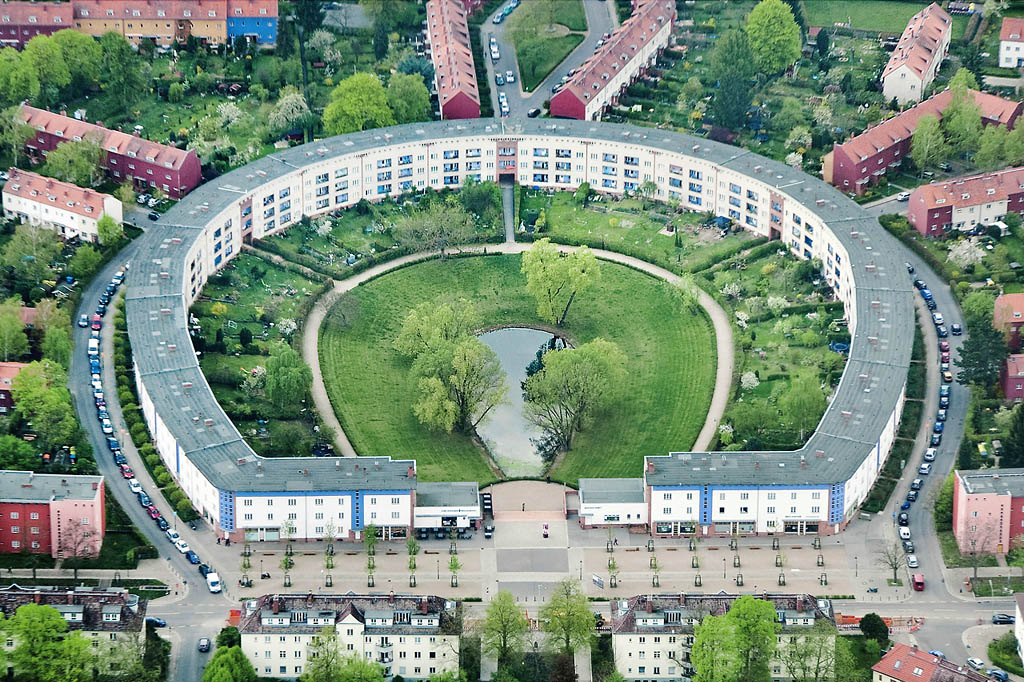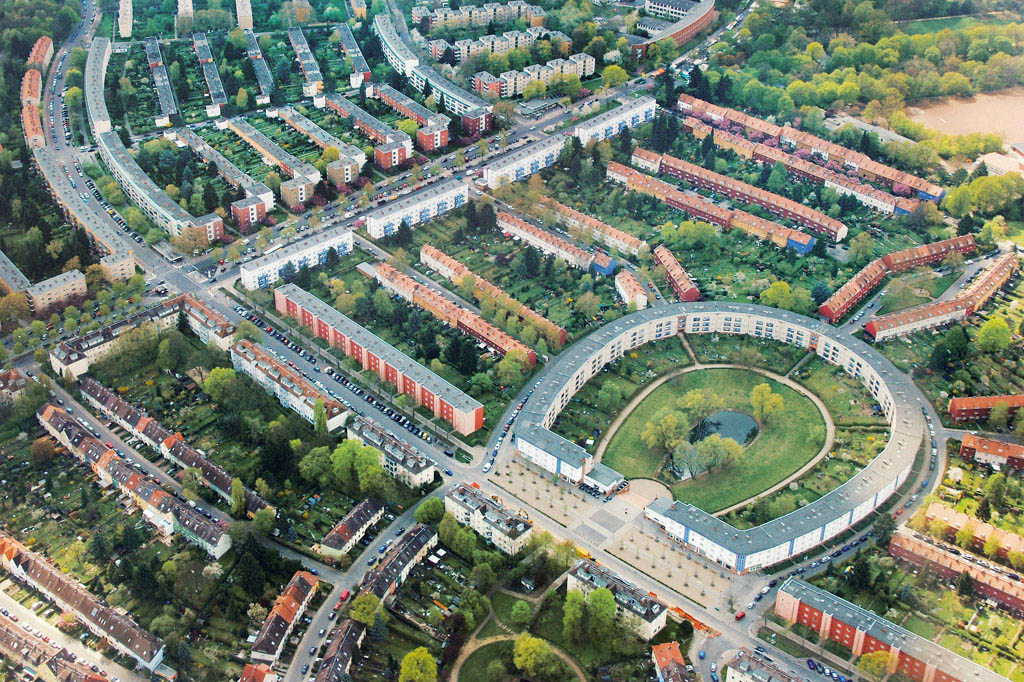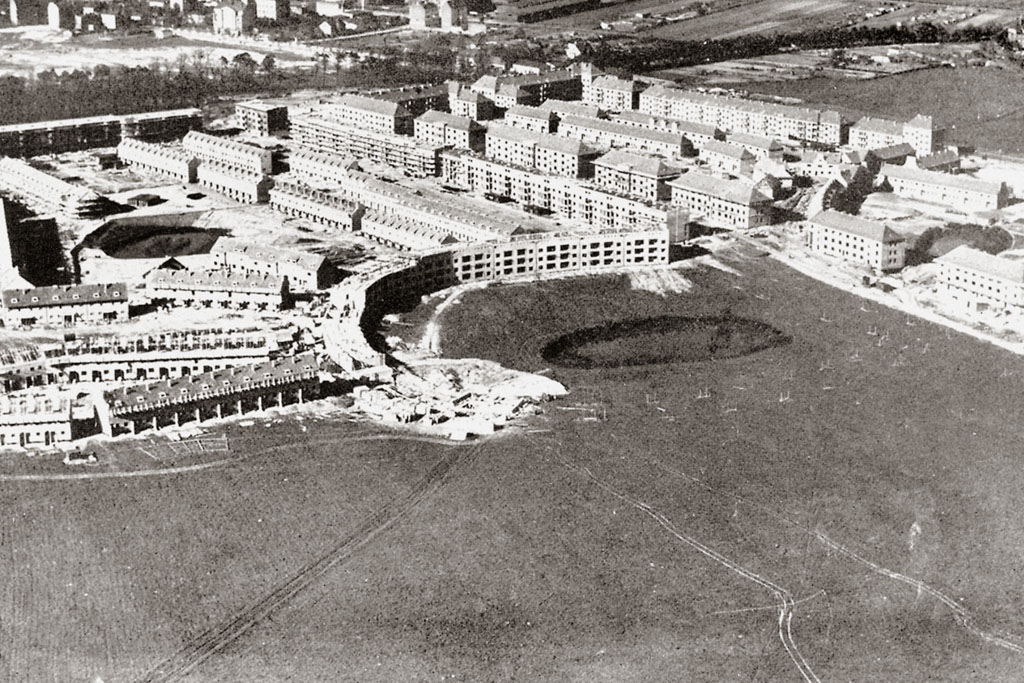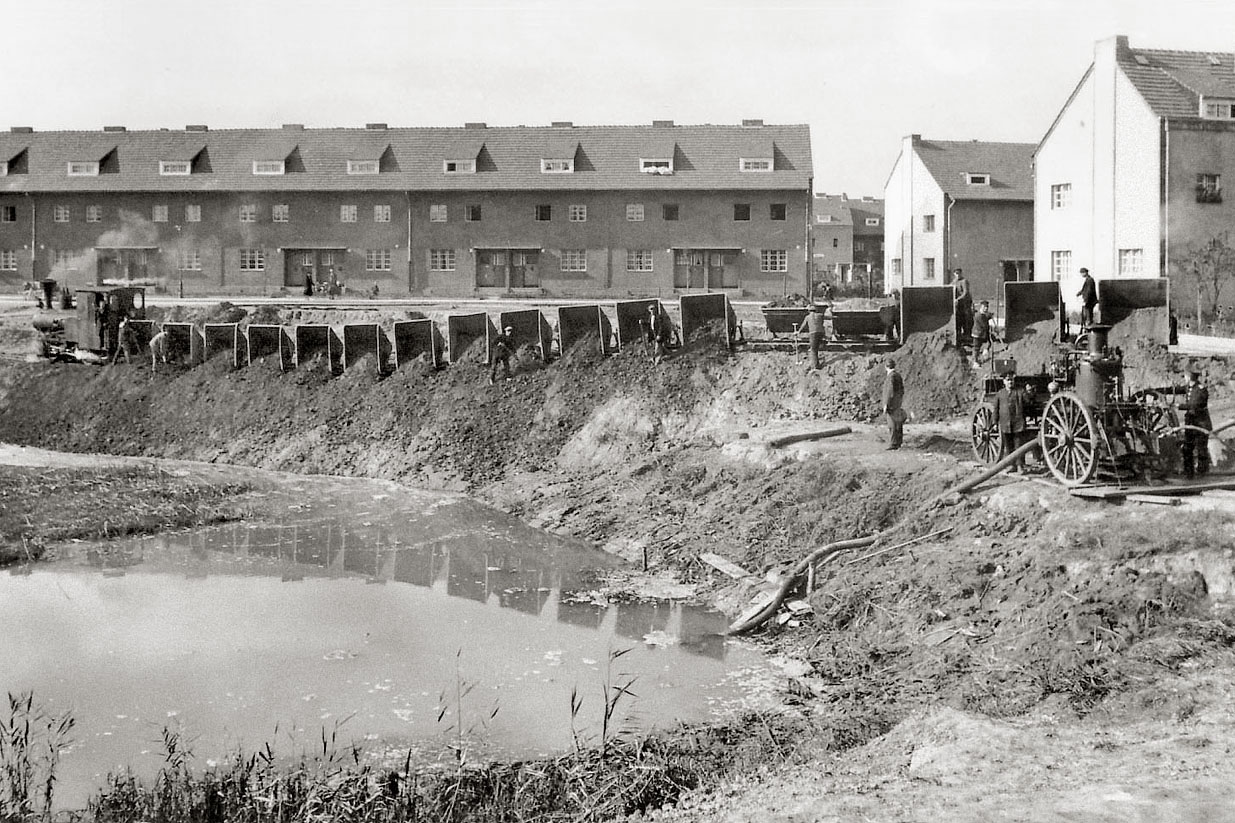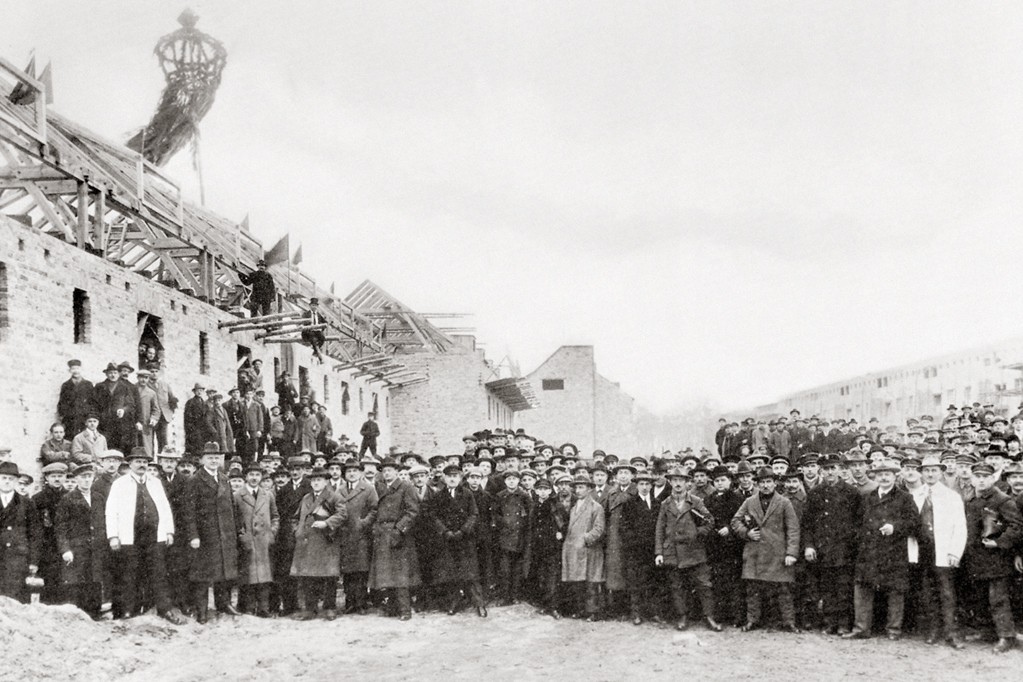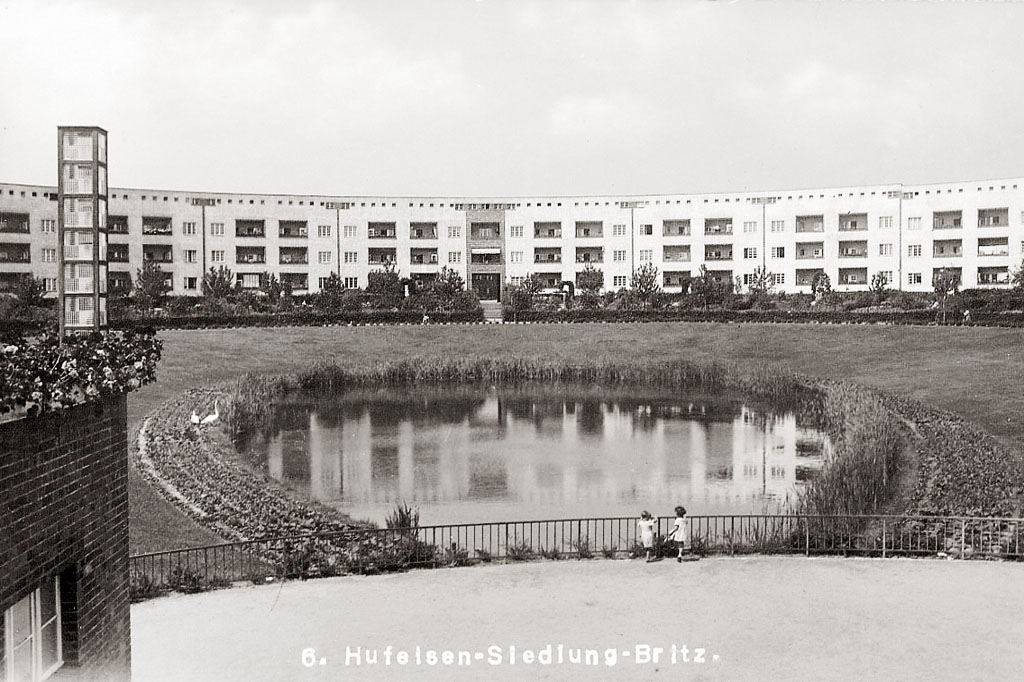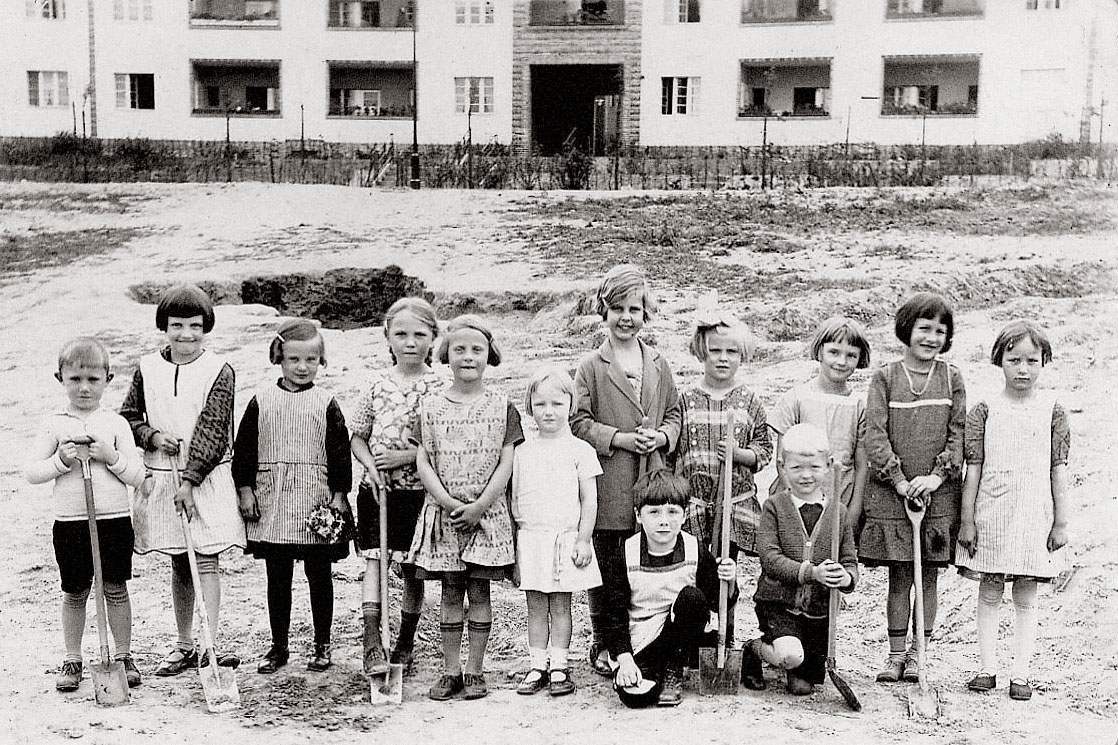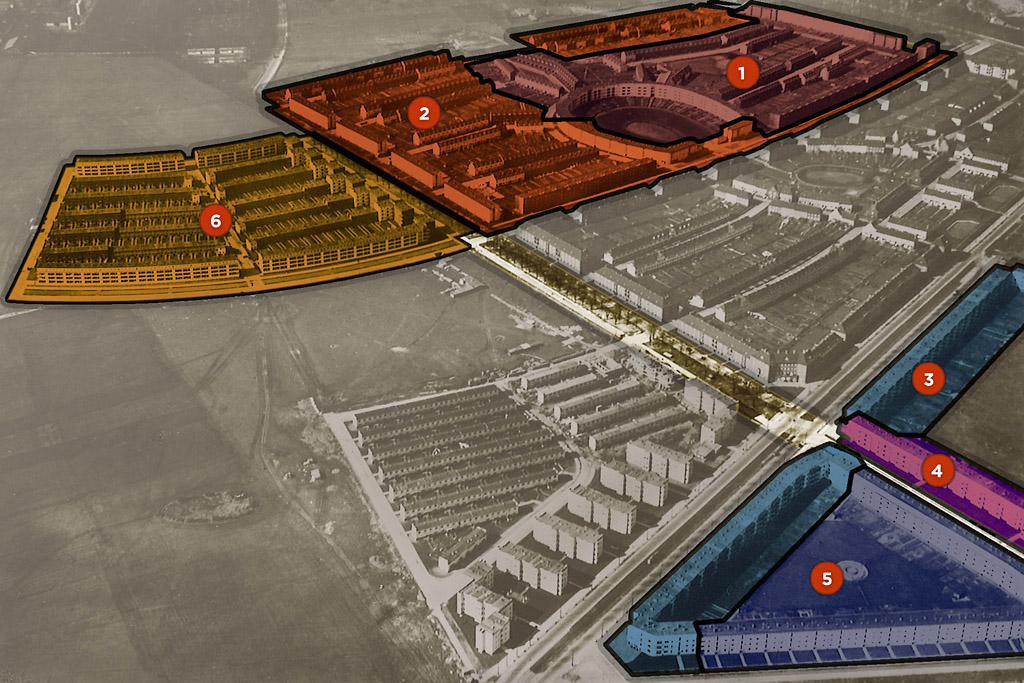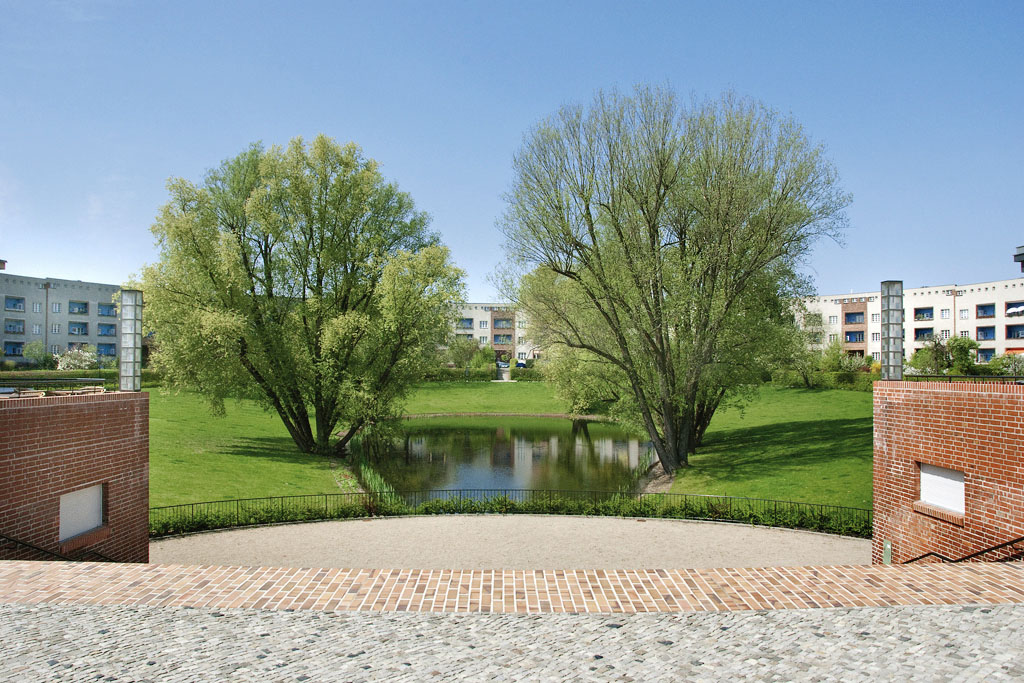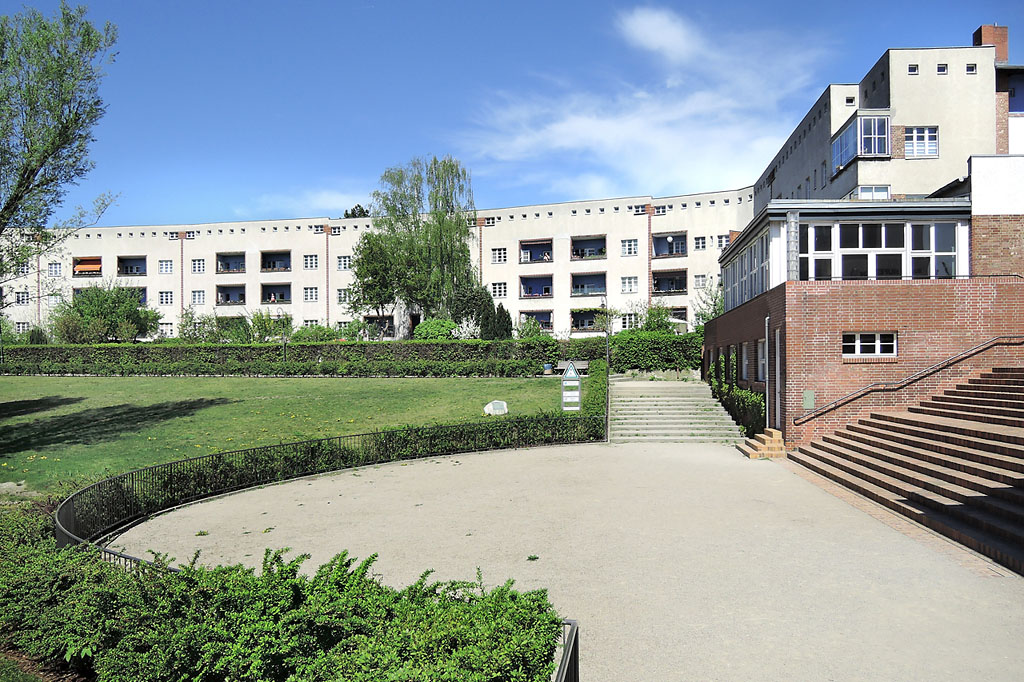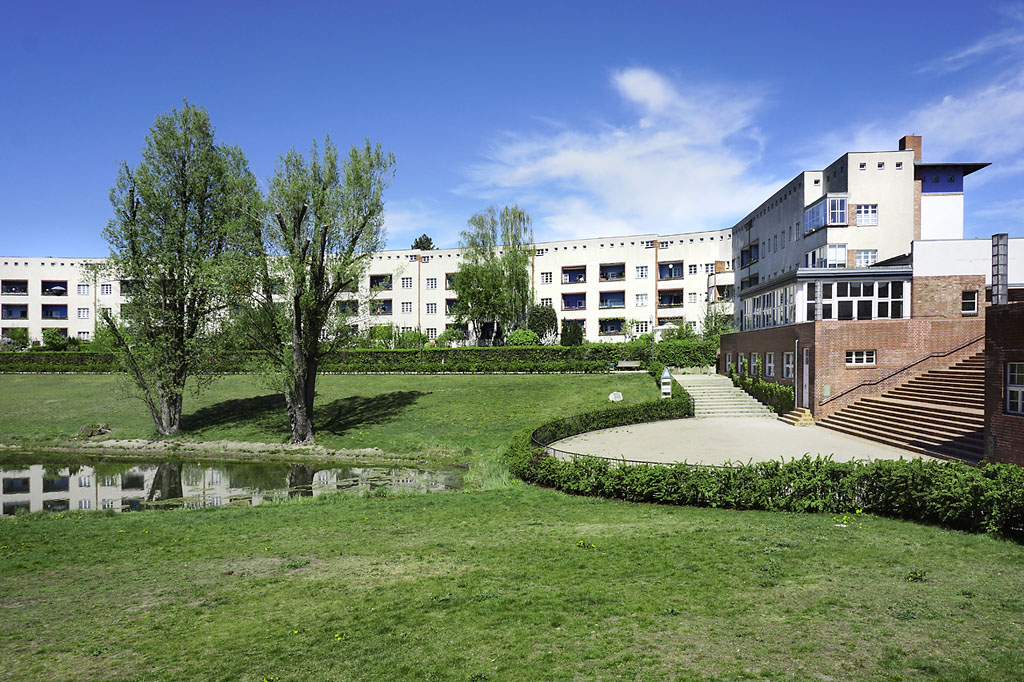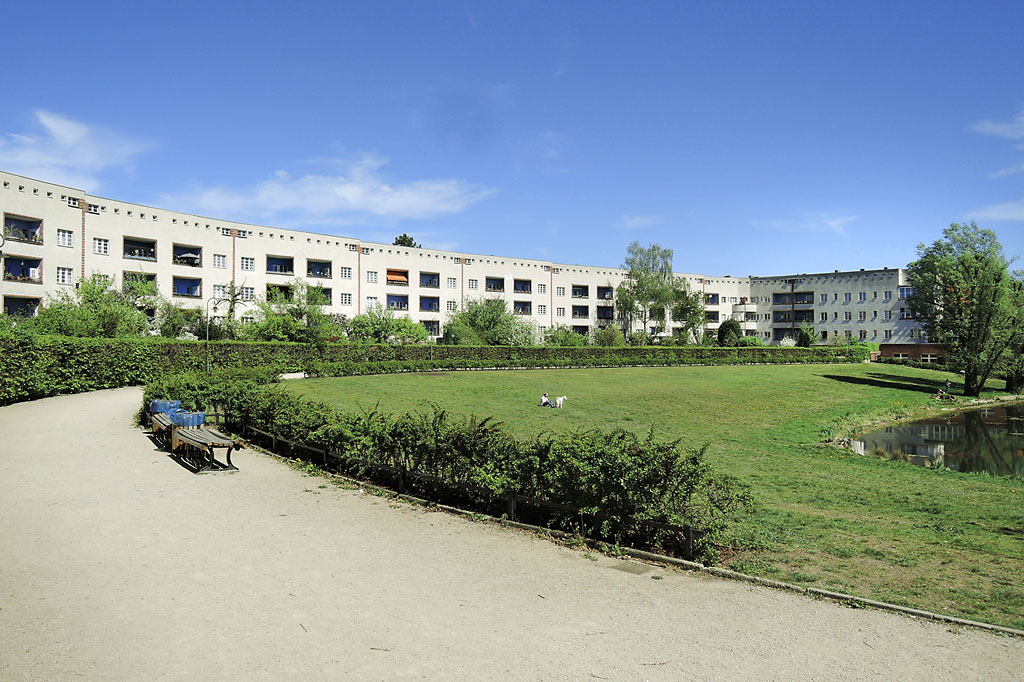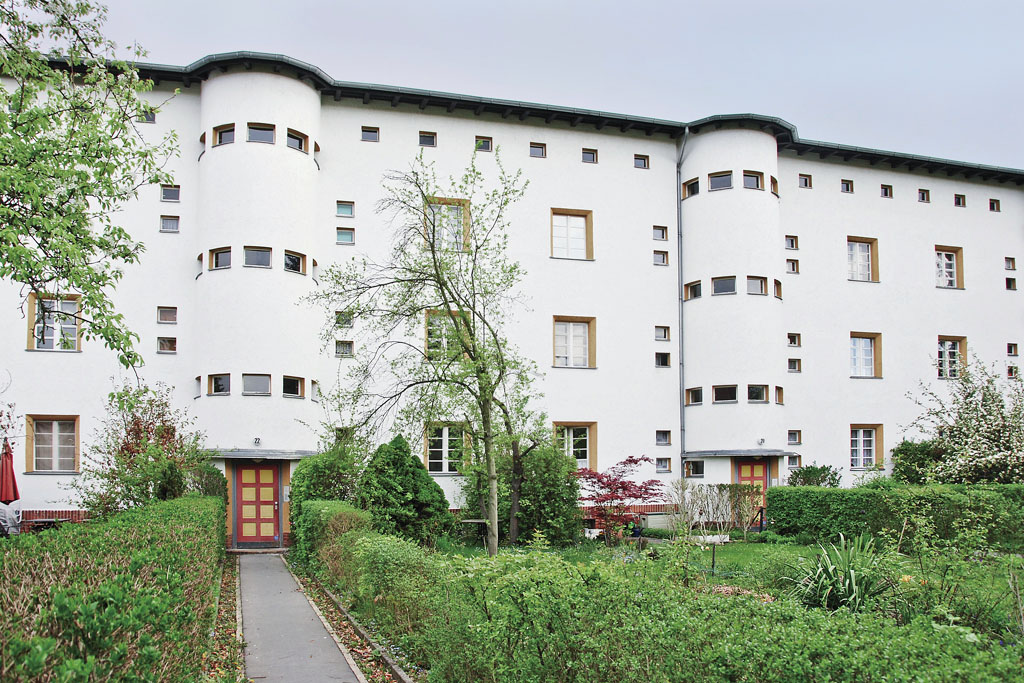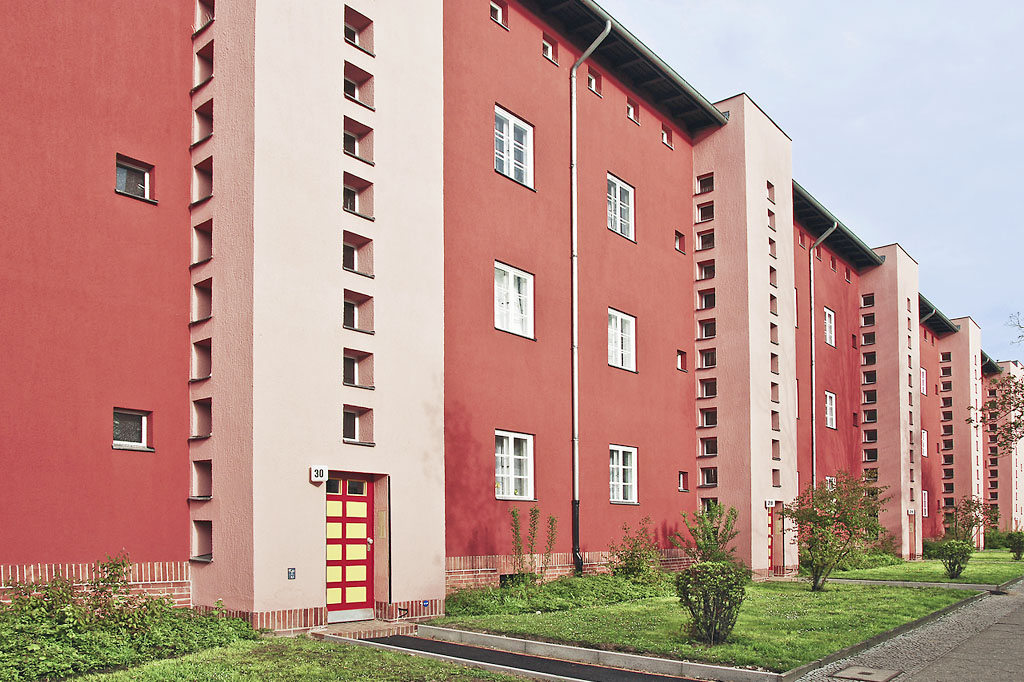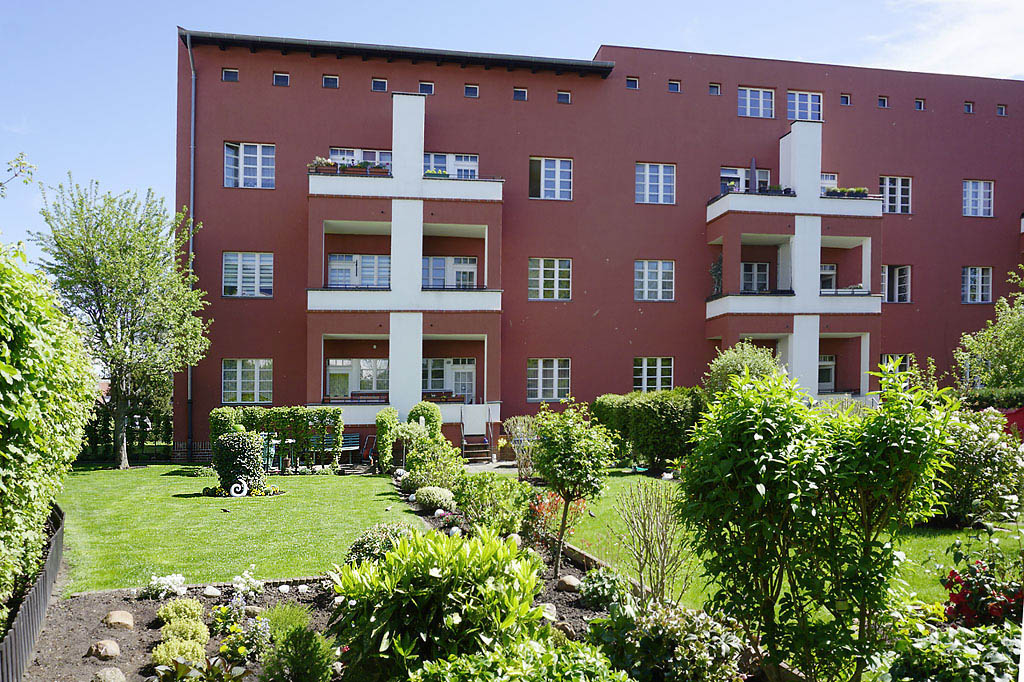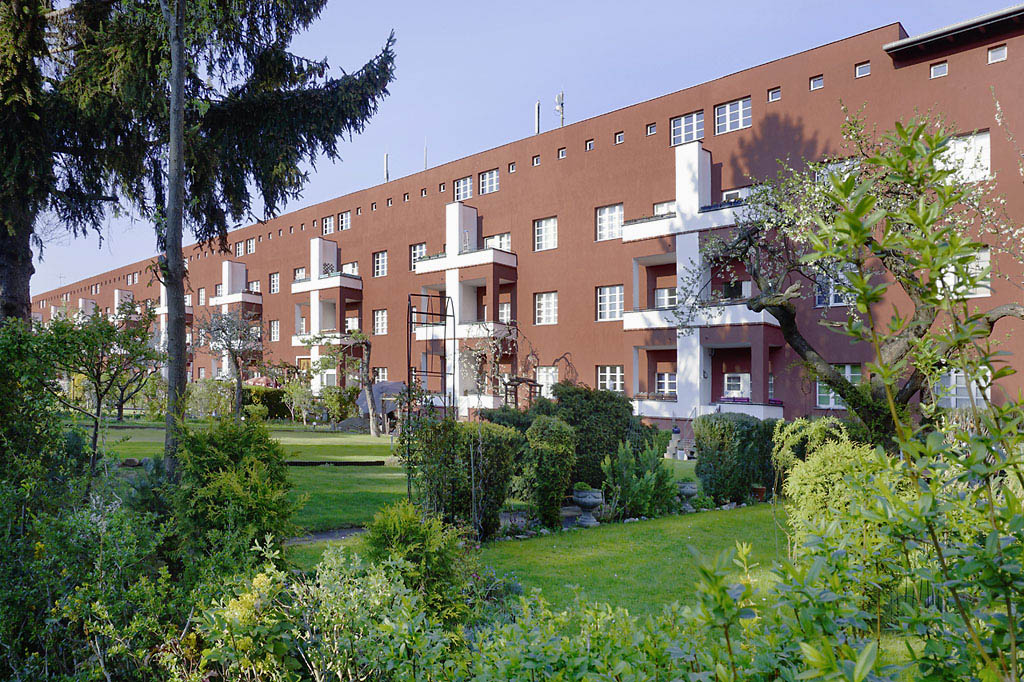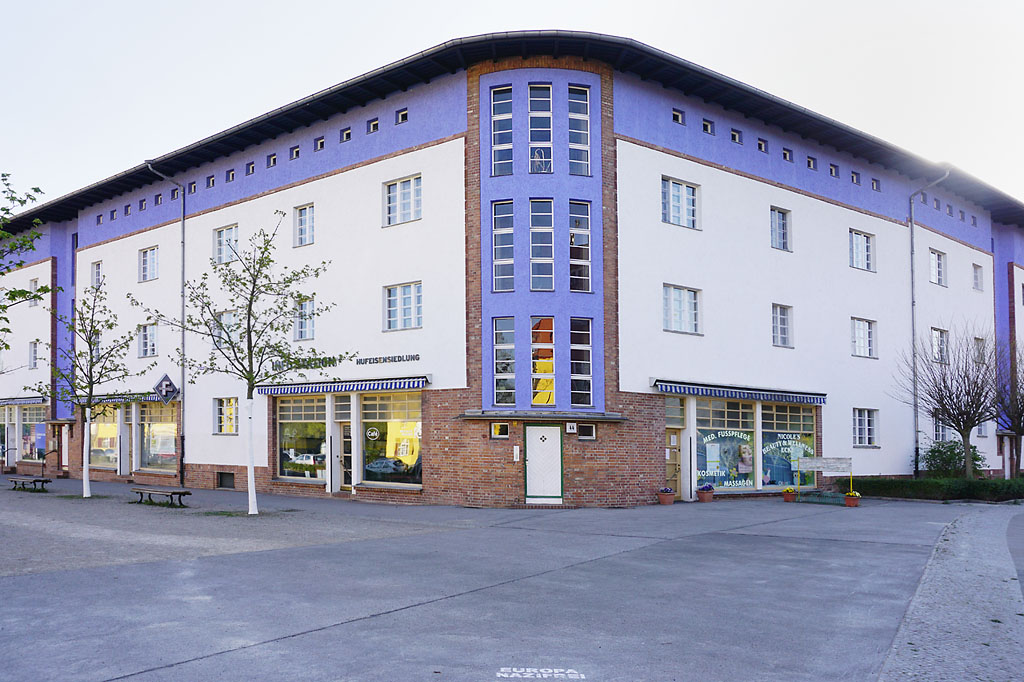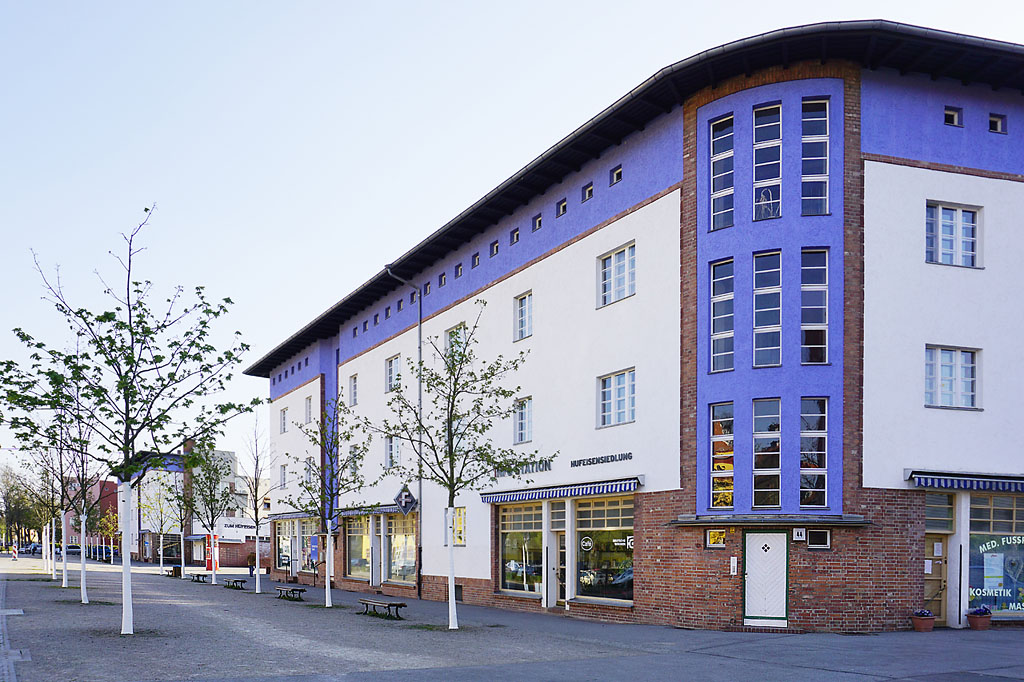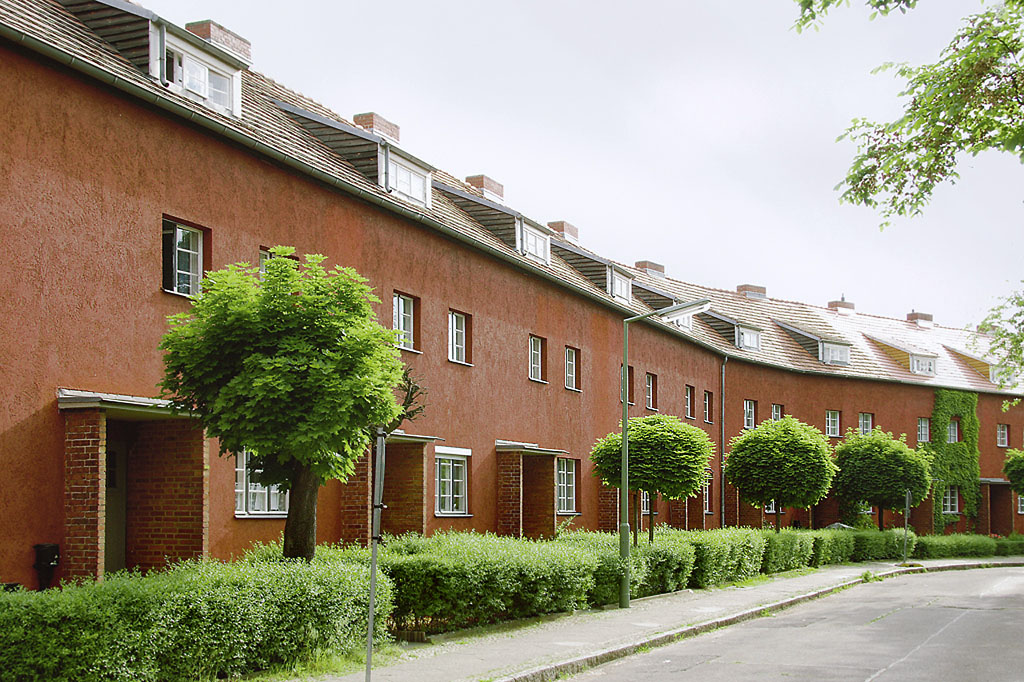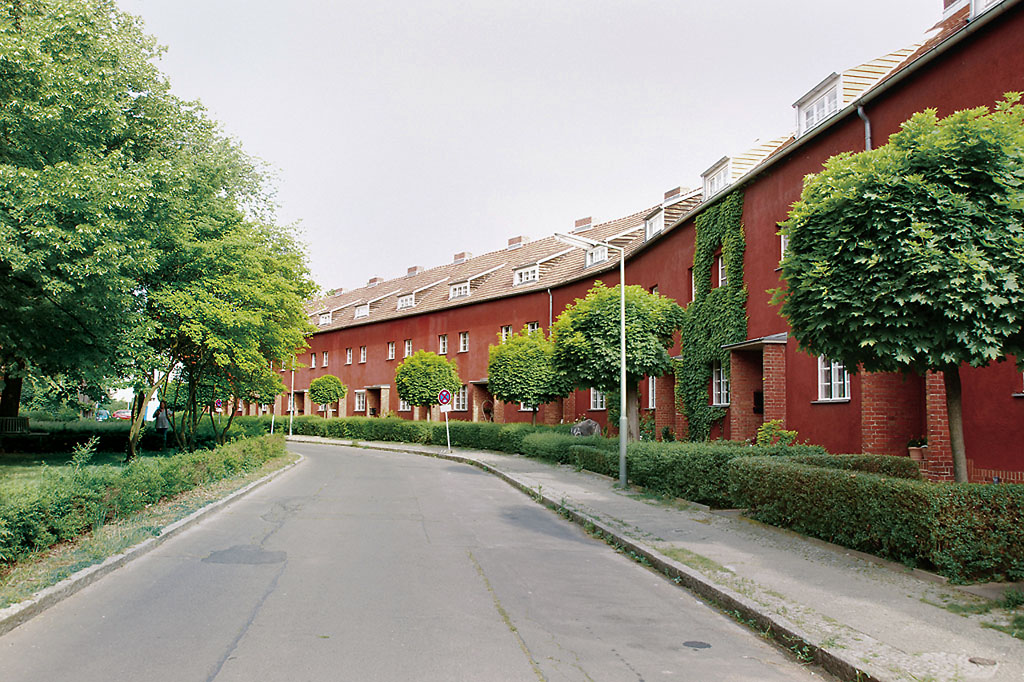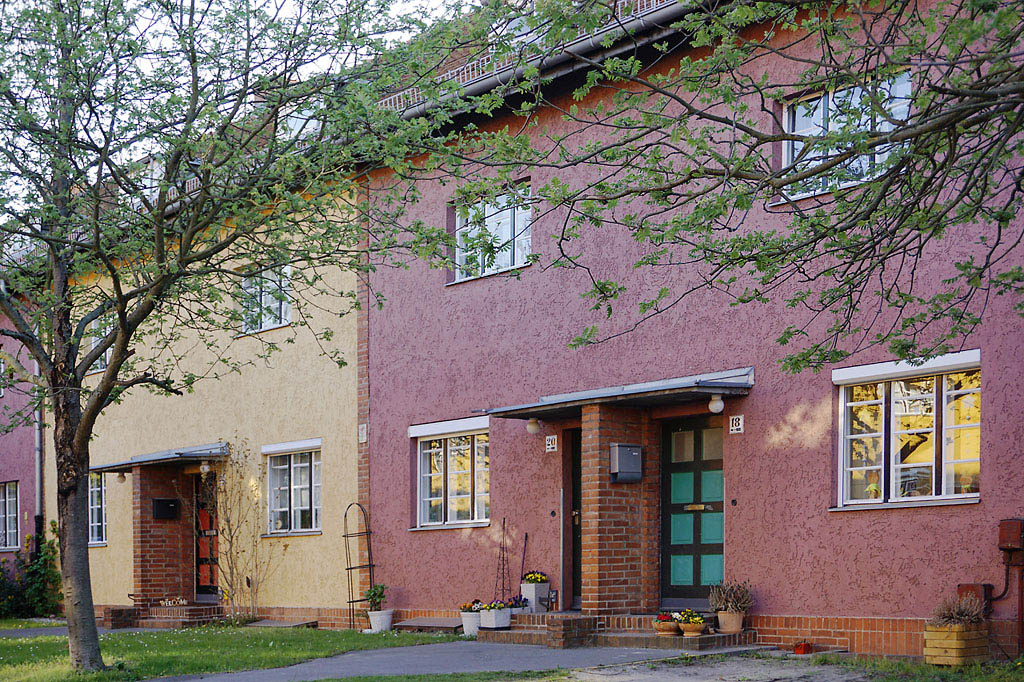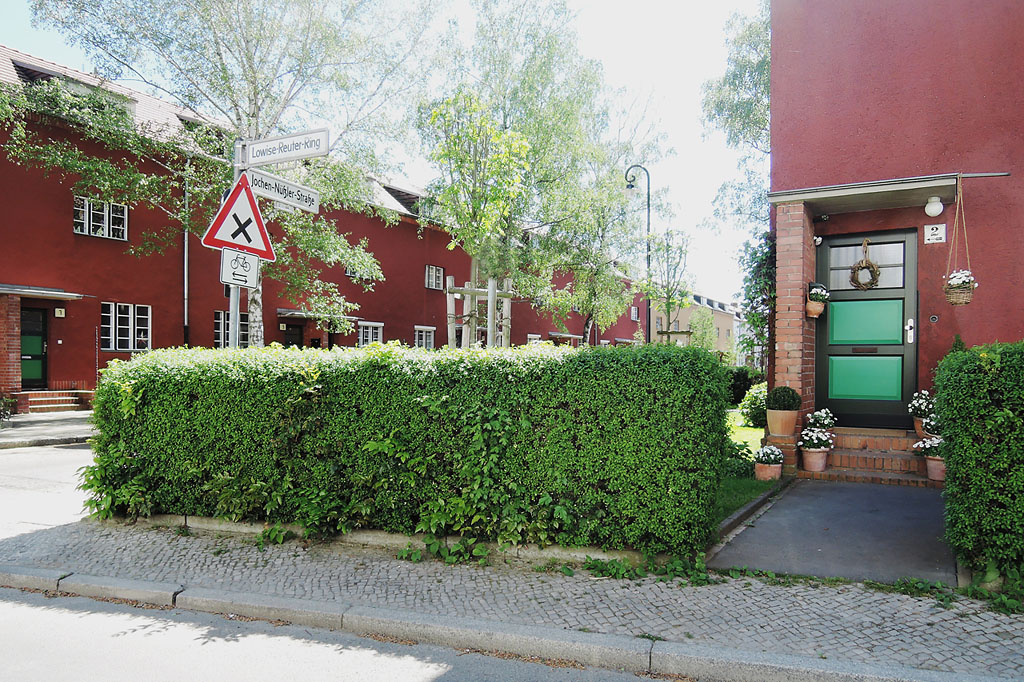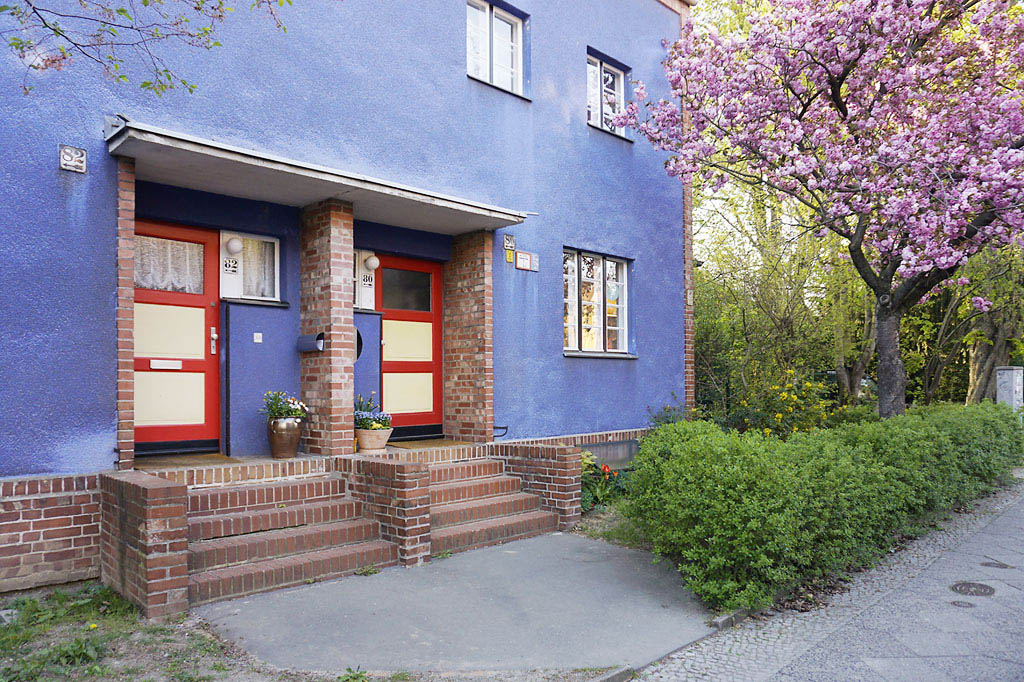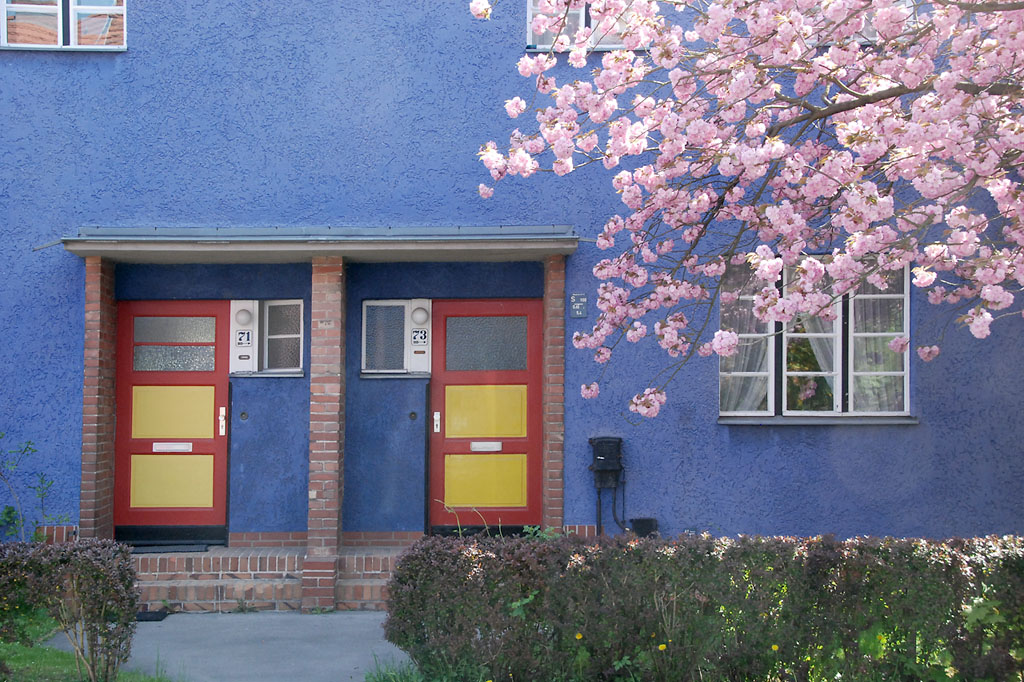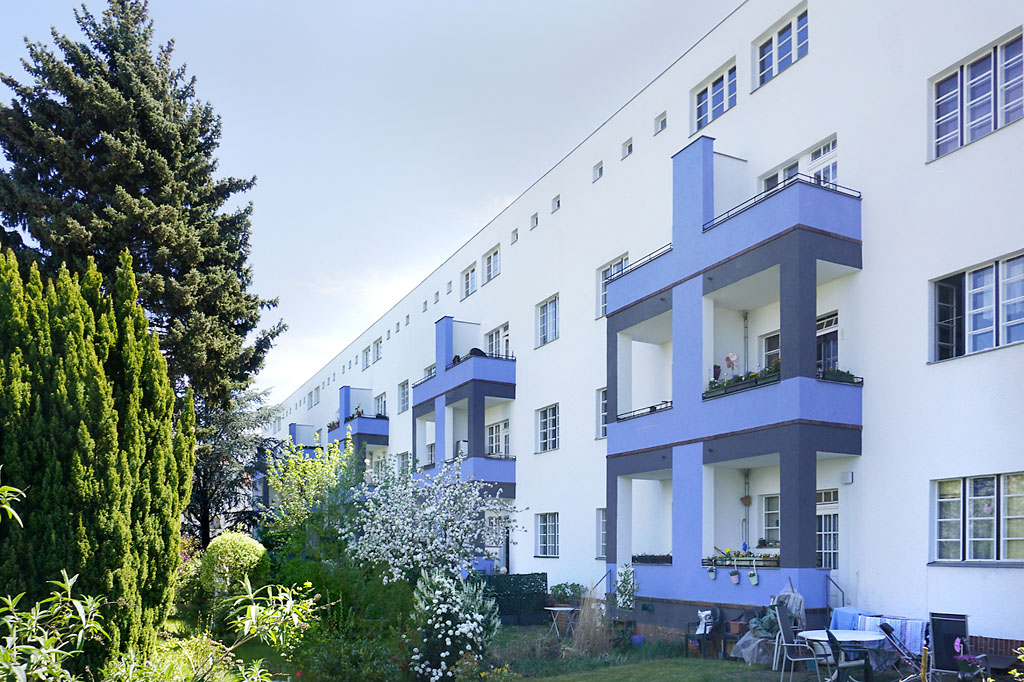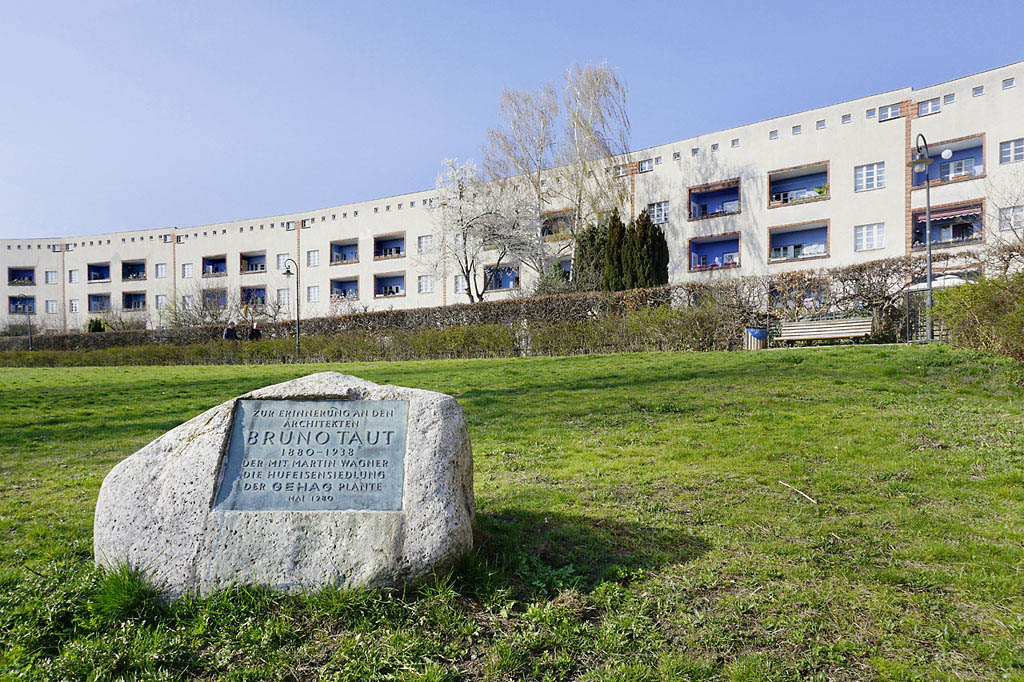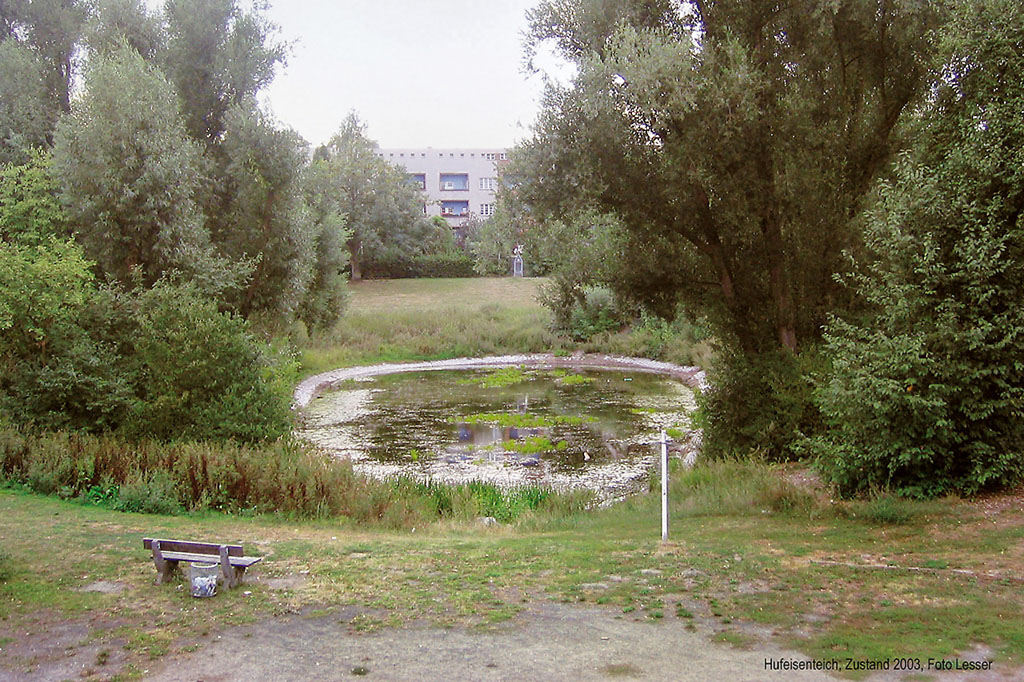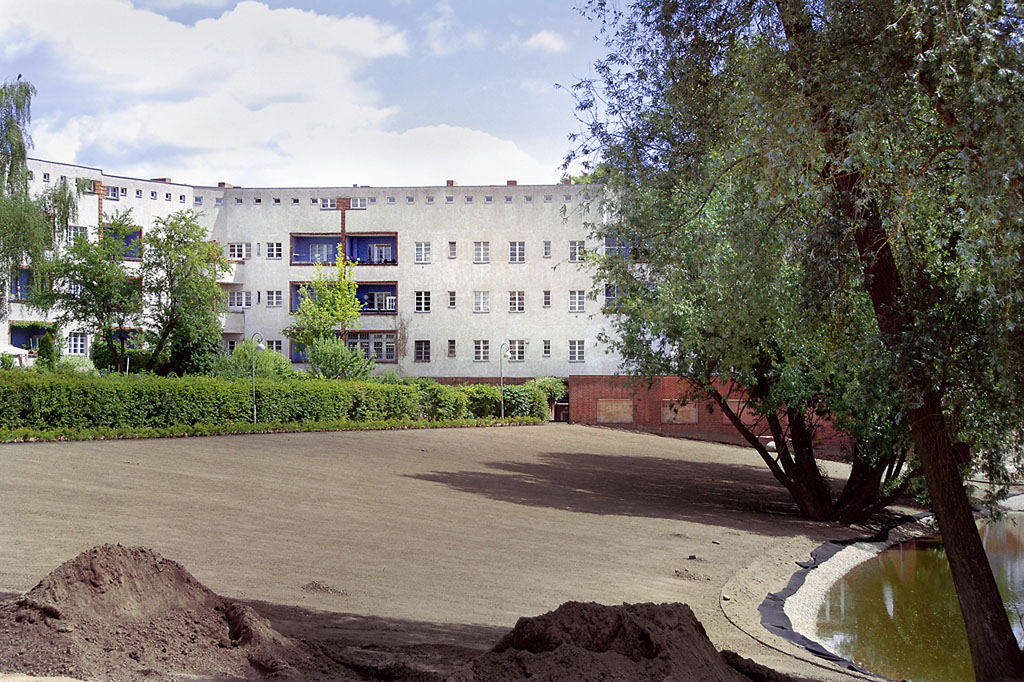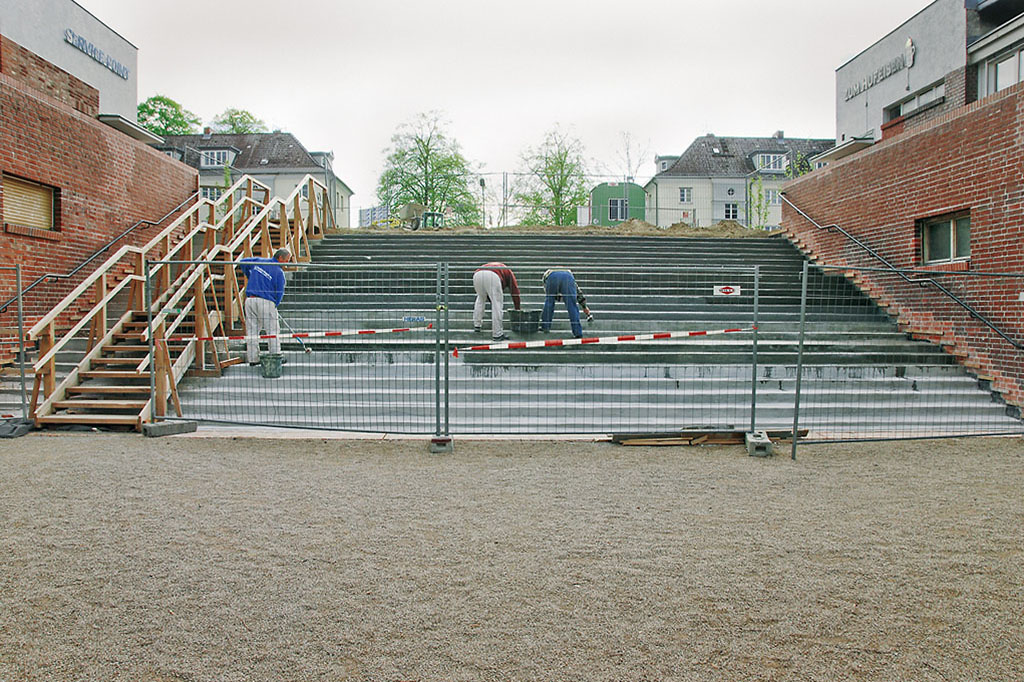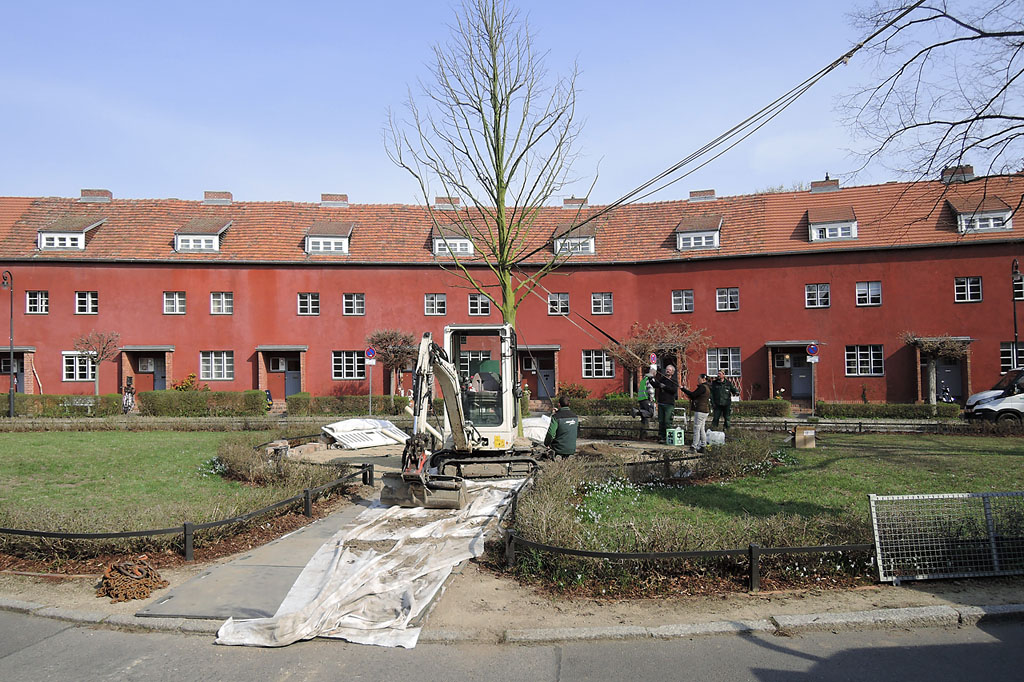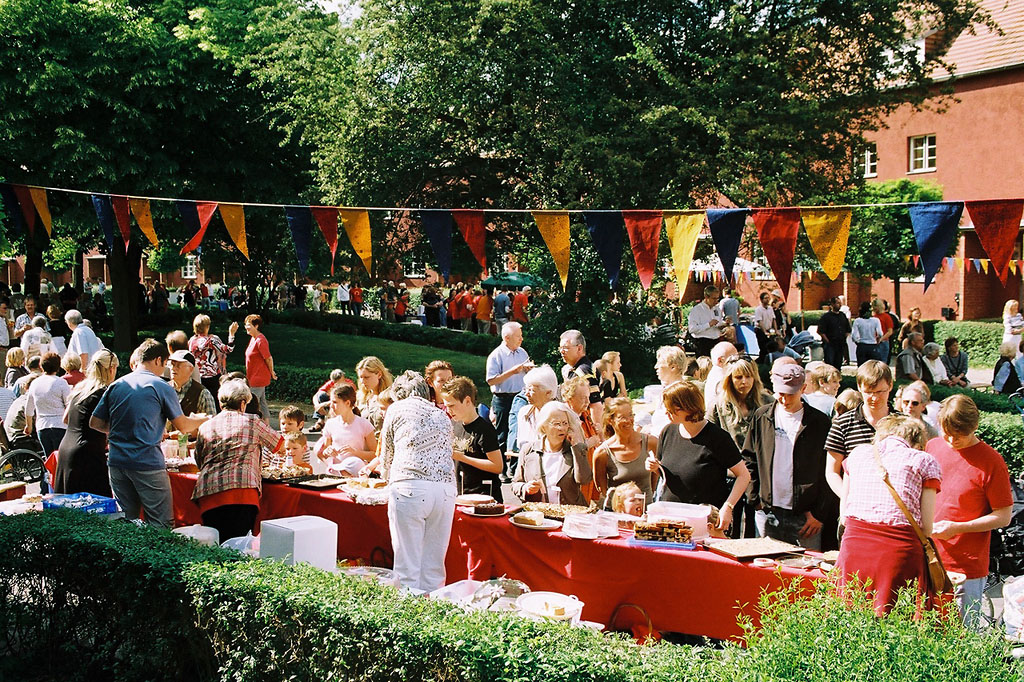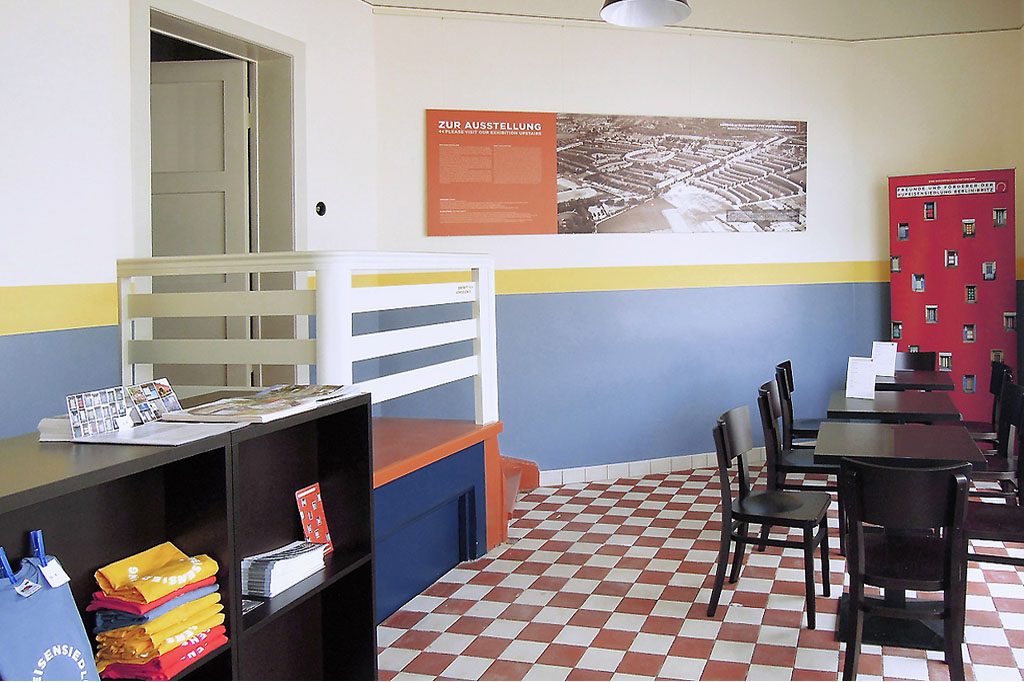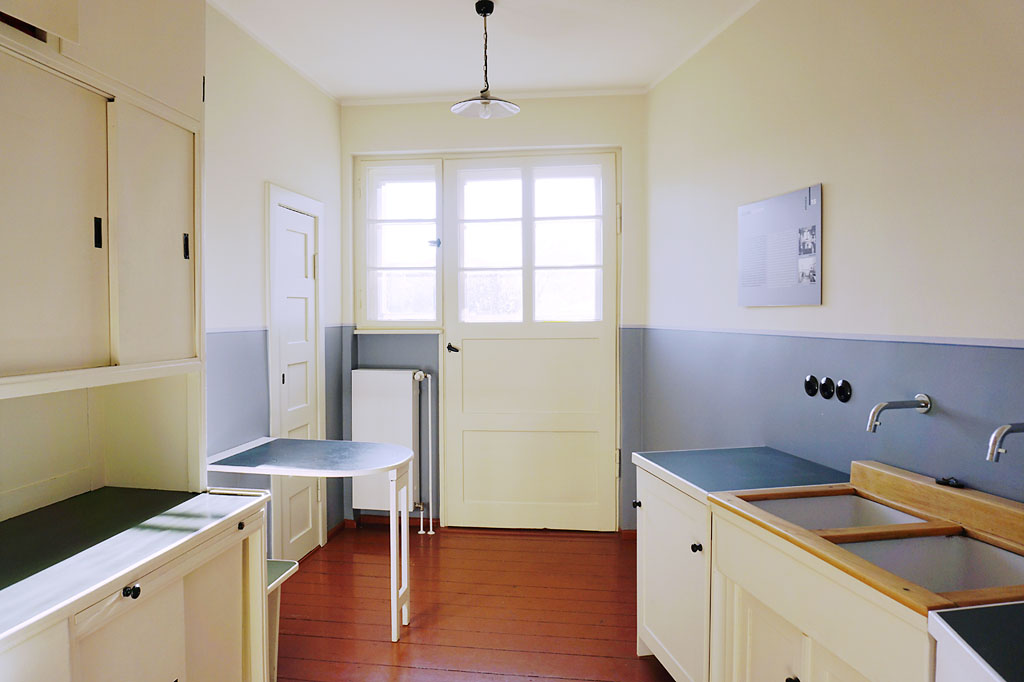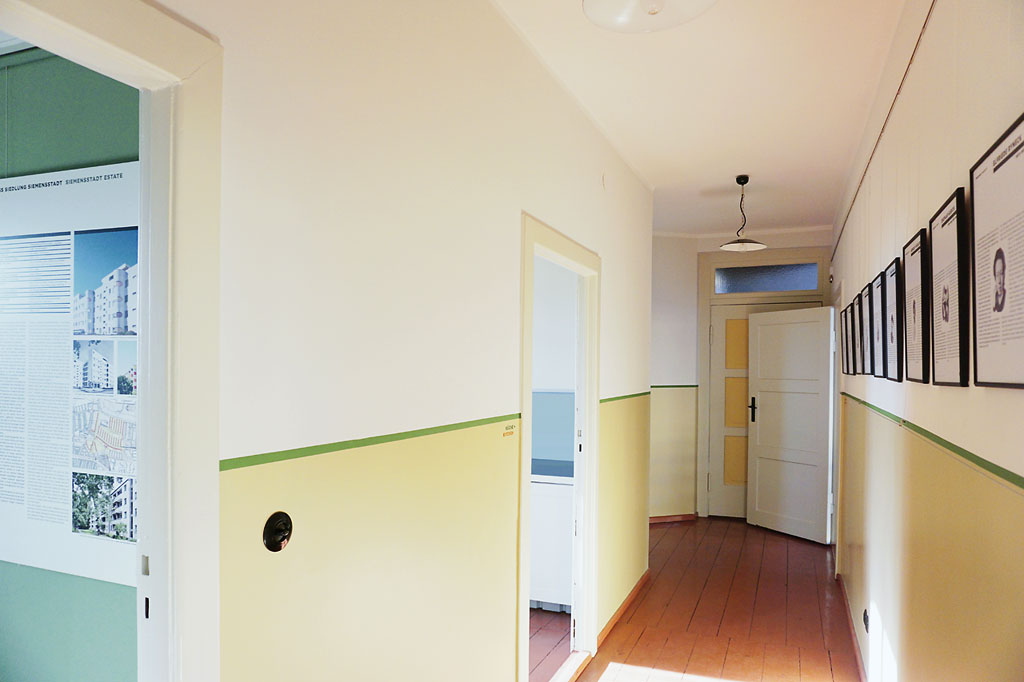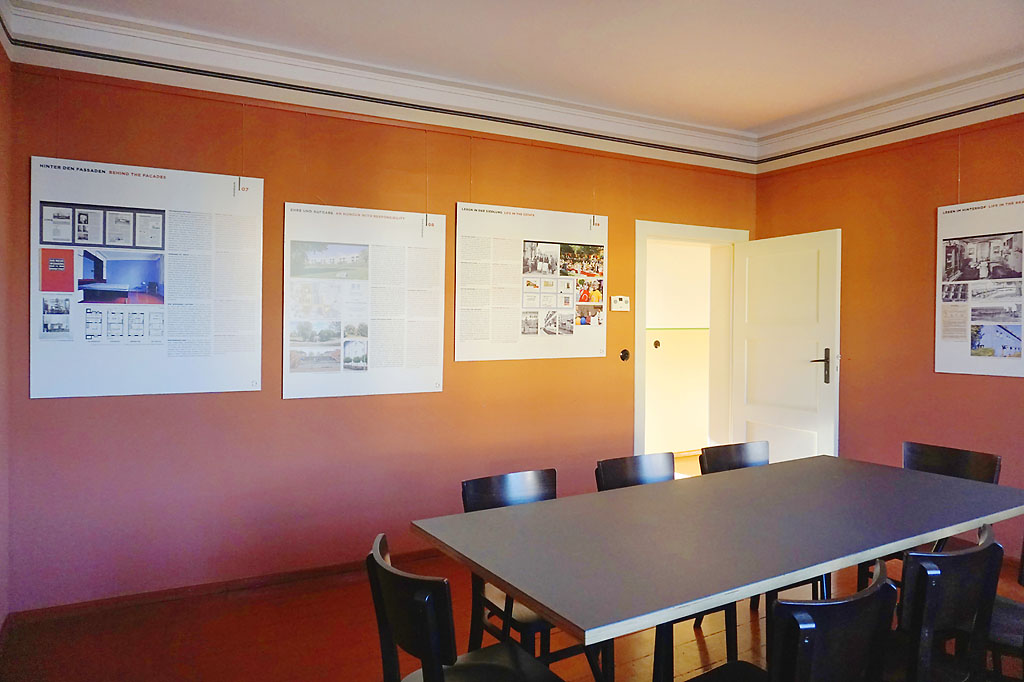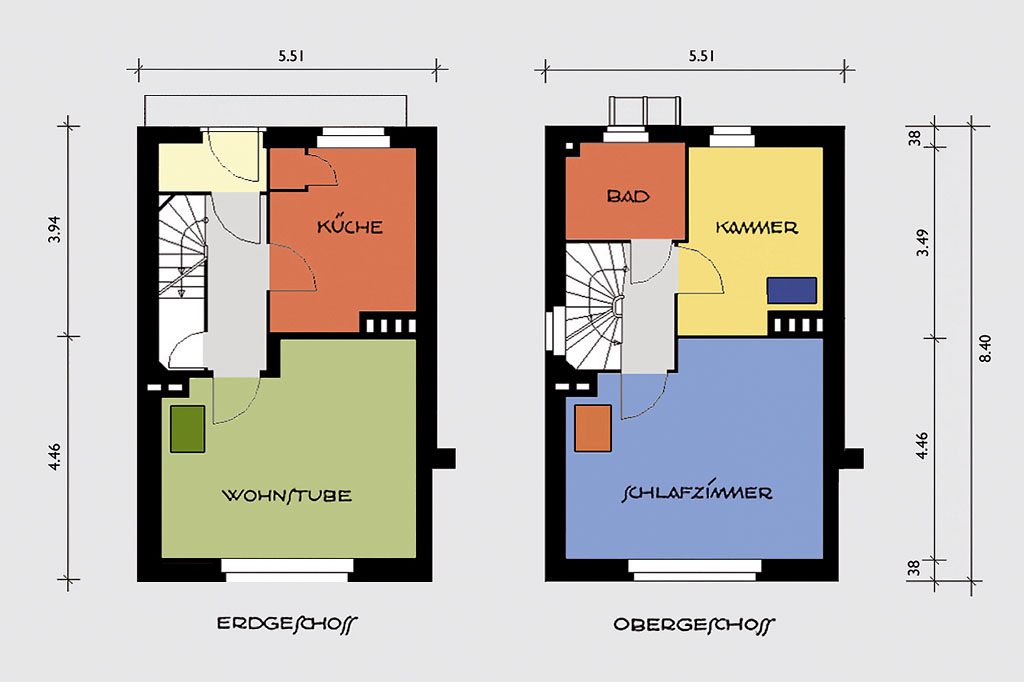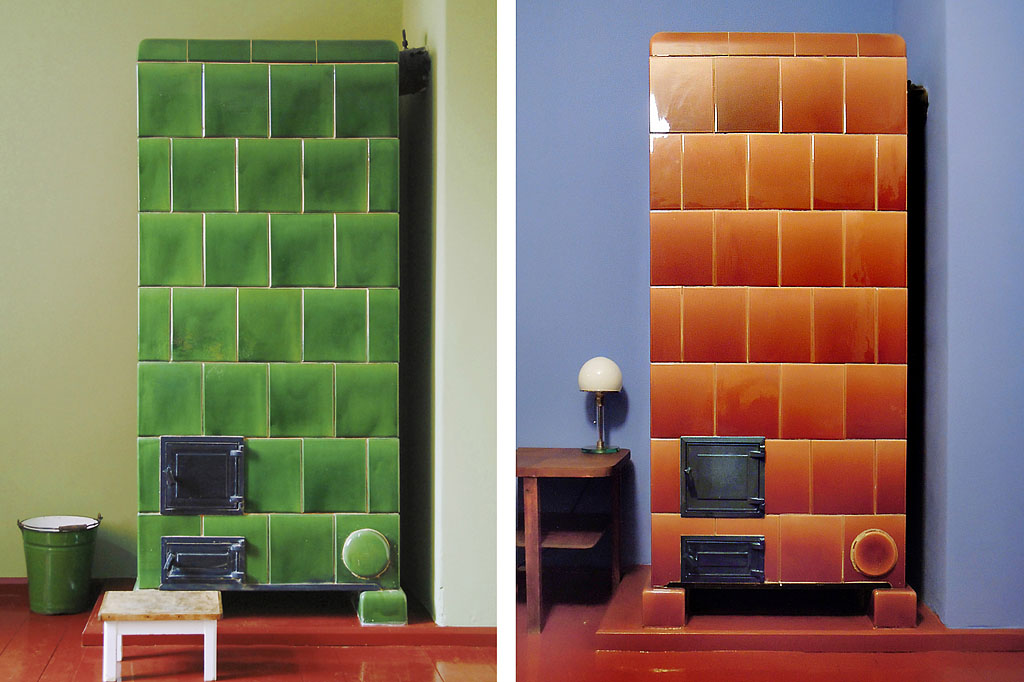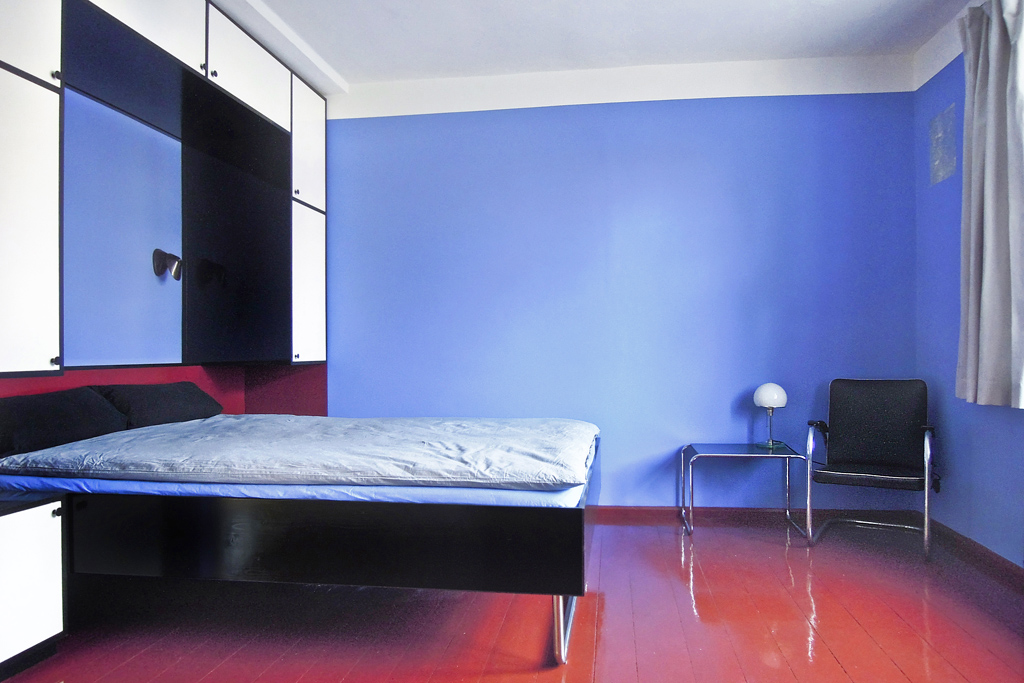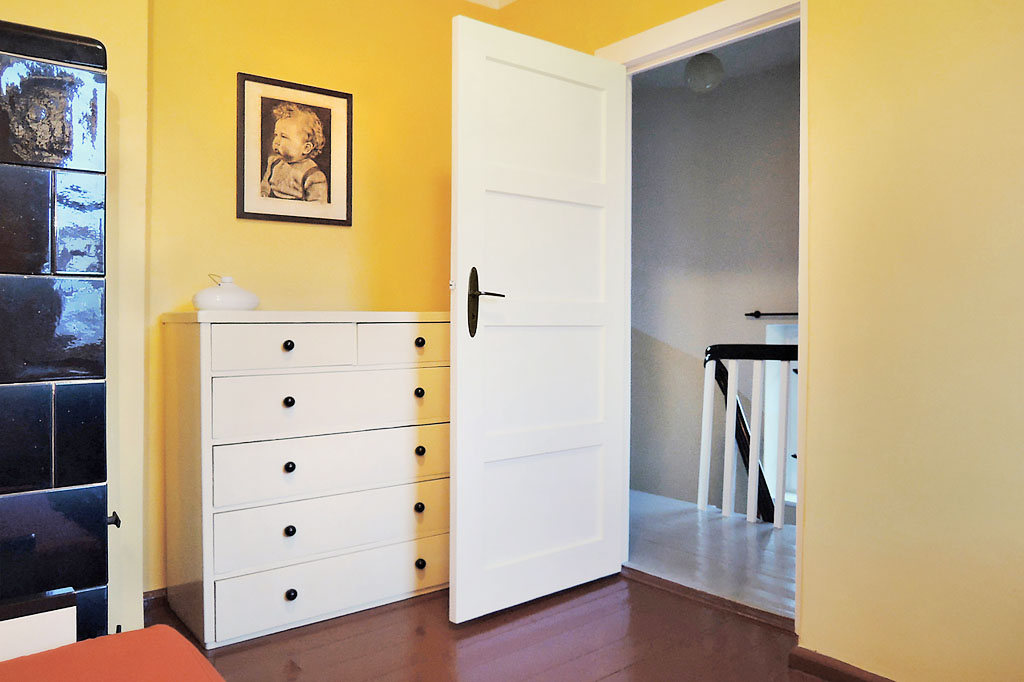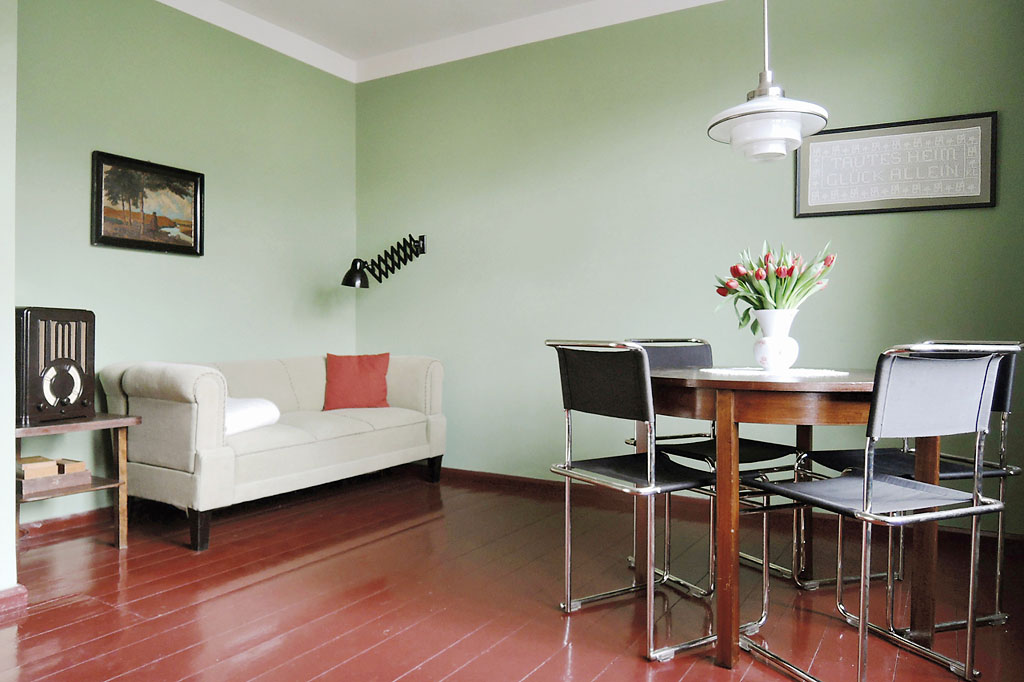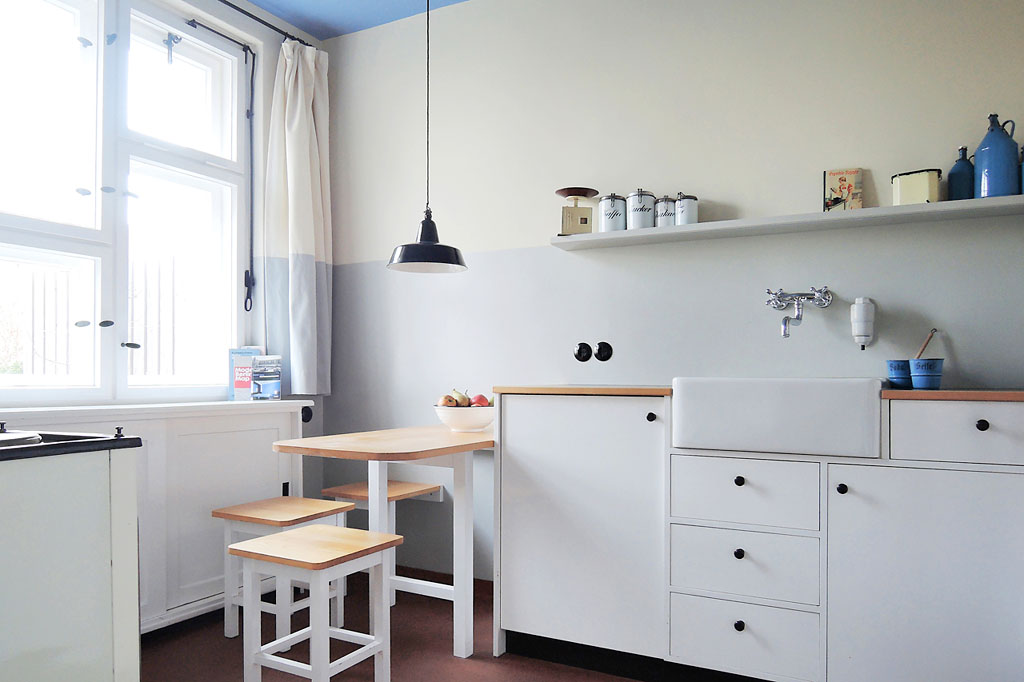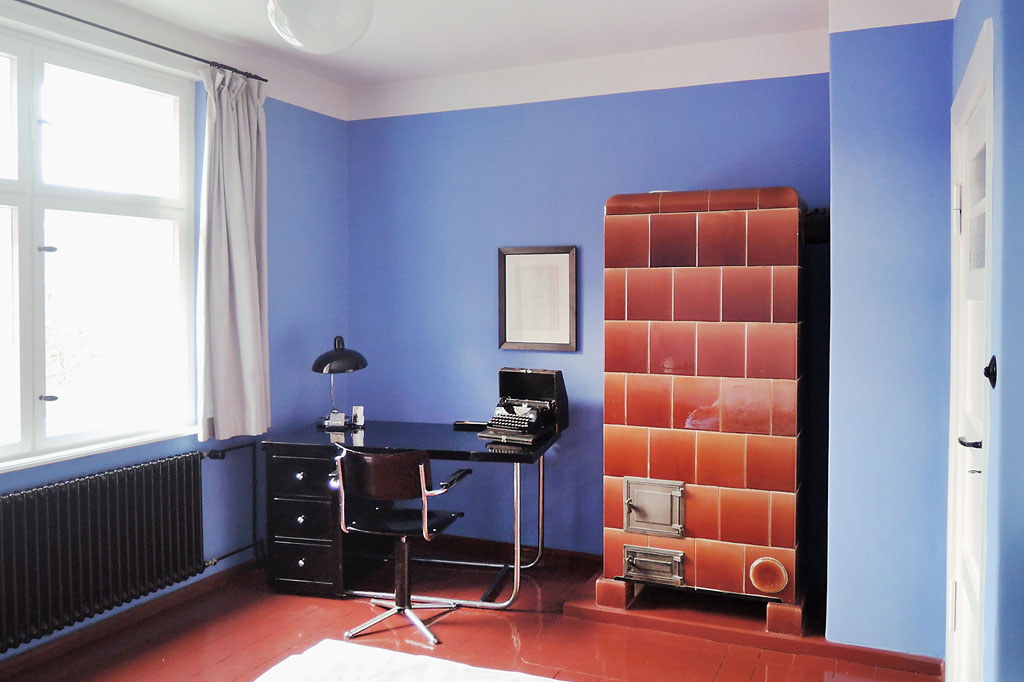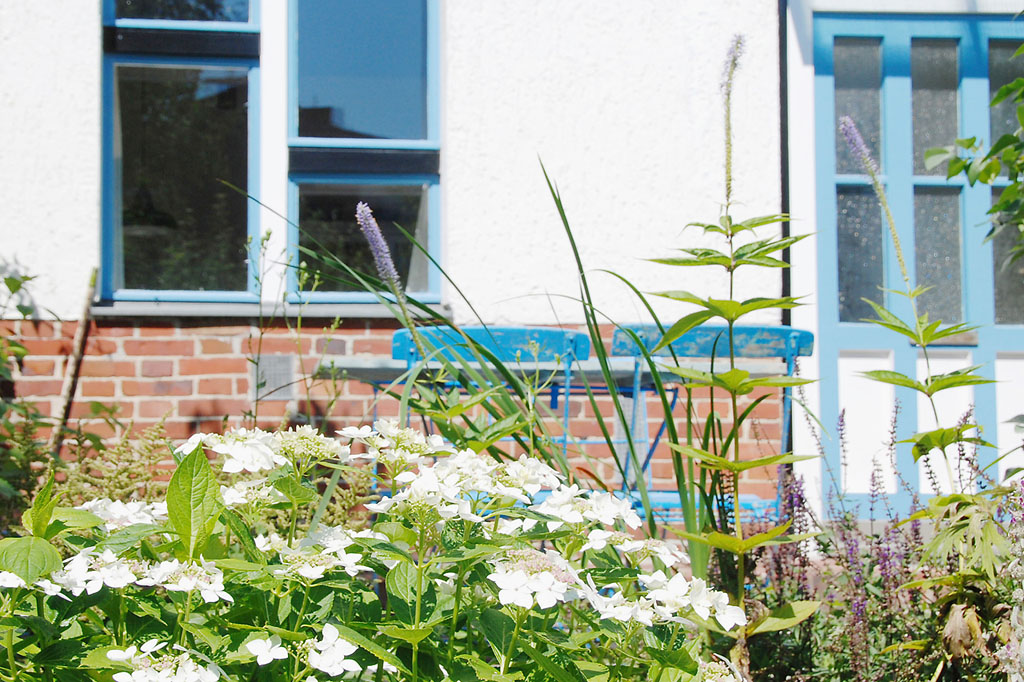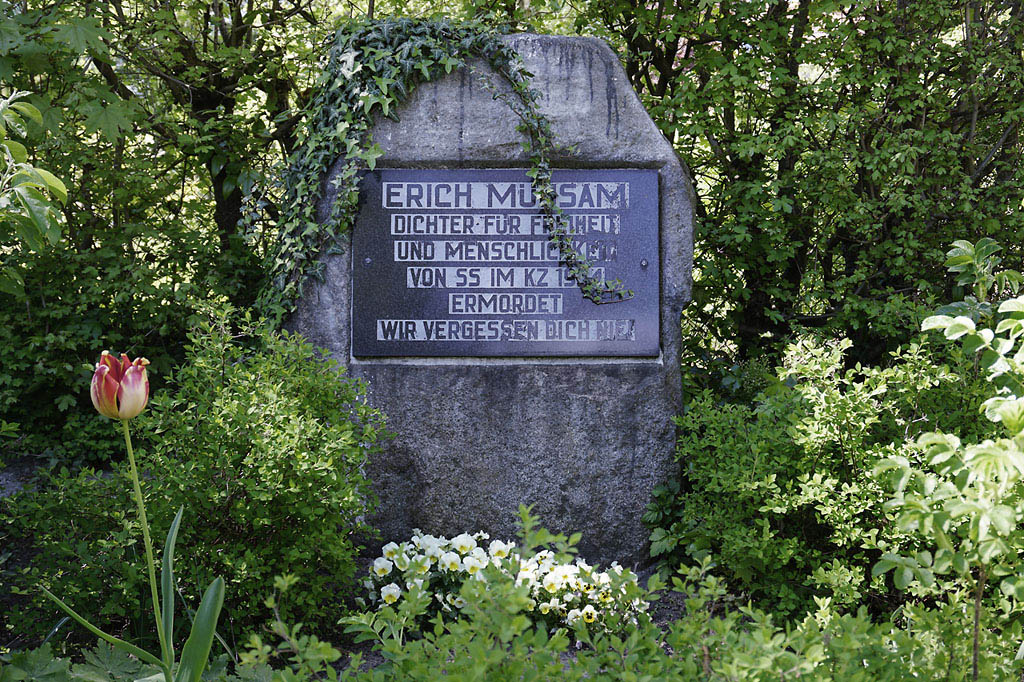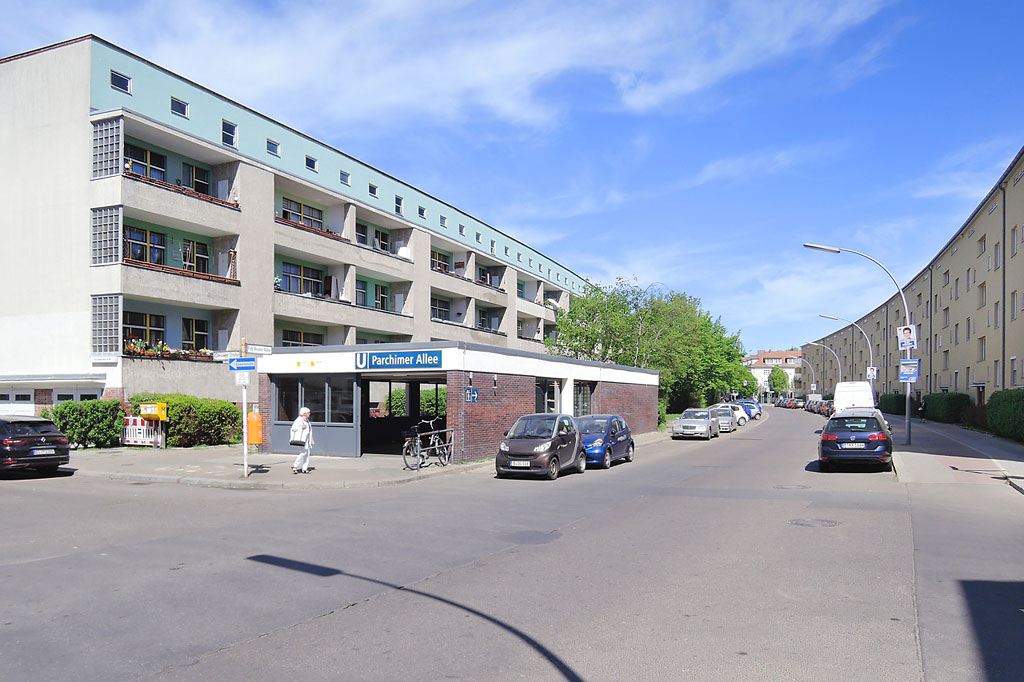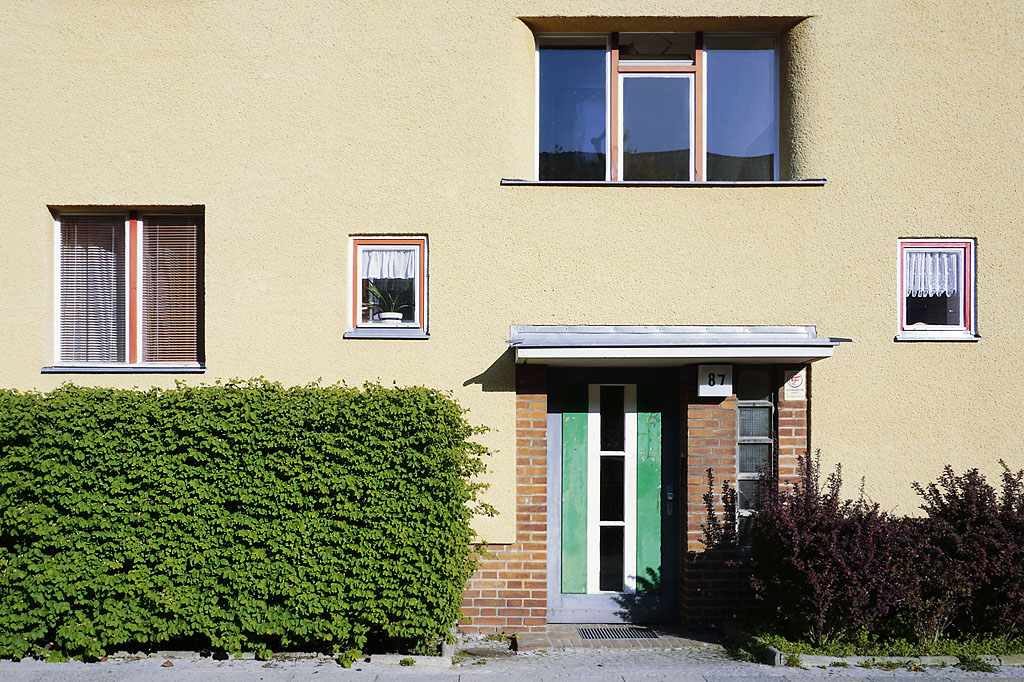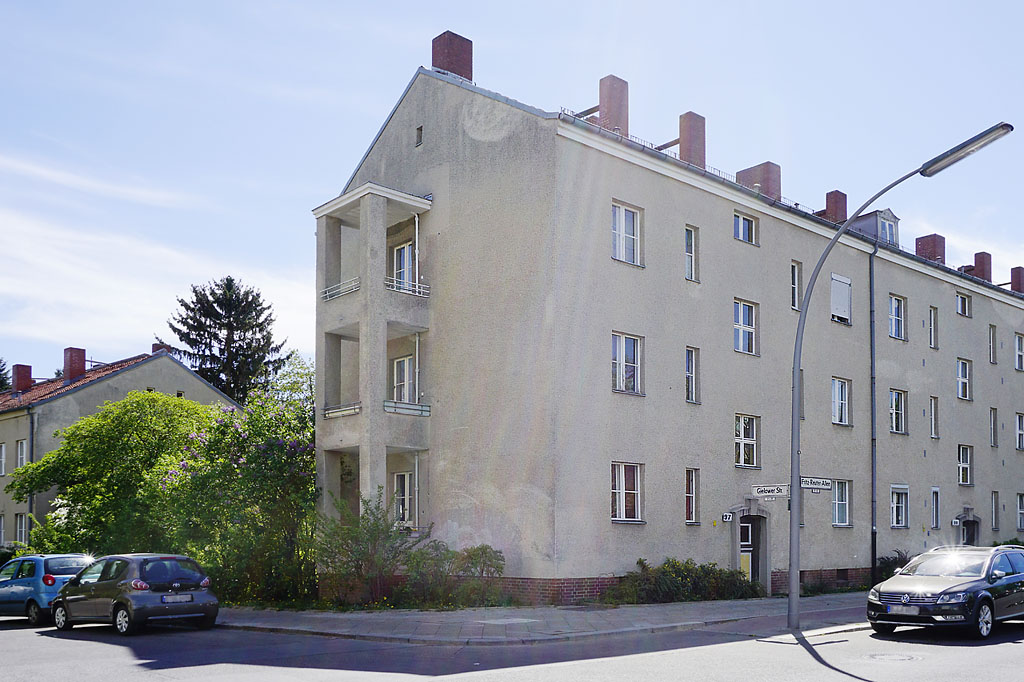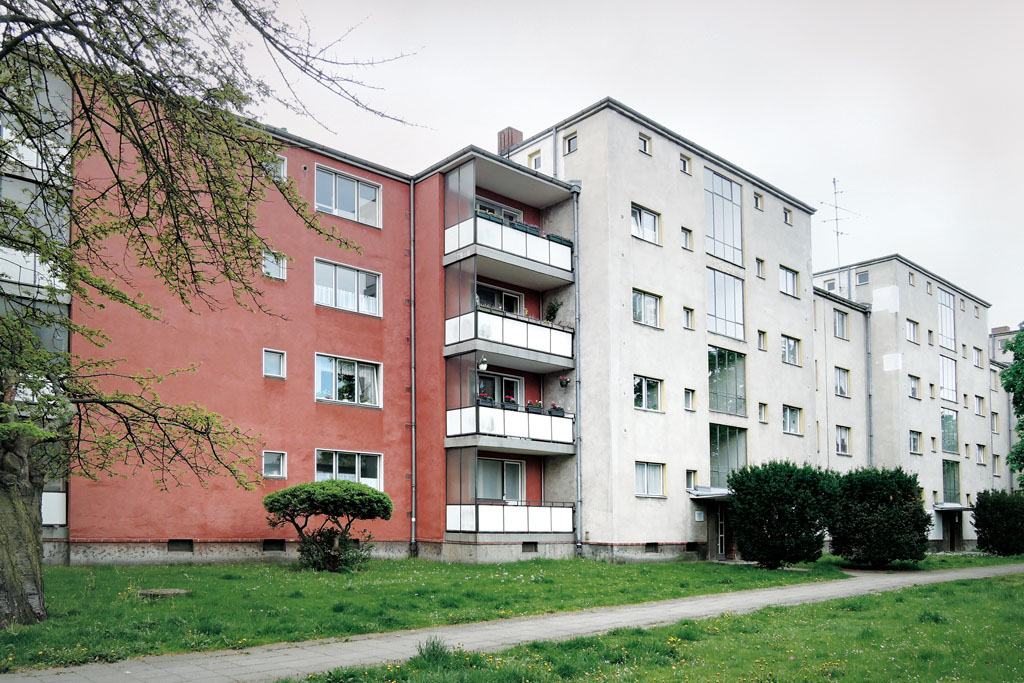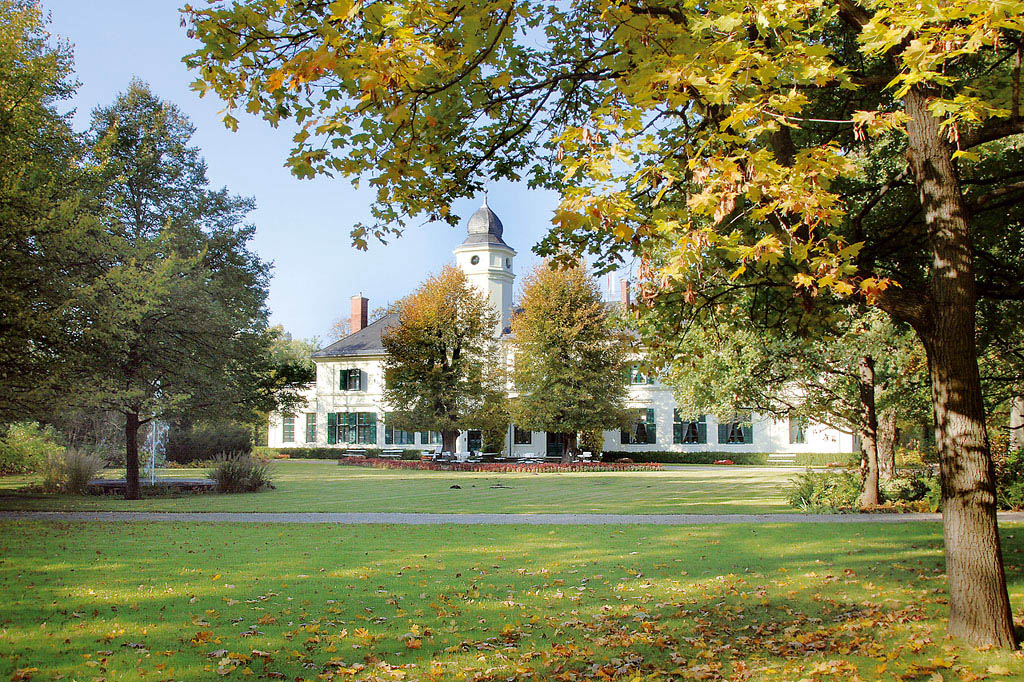Horseshoe Estate (1925–30)
Showpiece, icon and experimental lab
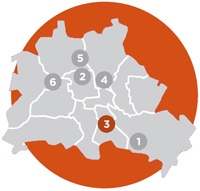
Facts
- District: Neukölln, locality Britz
- Public transport: U-Bhf. Blaschkoallee / Parchimer Allee
- Total area of world heritage: 37.1 hectares
- Total area of additional buffer zone: 73.1 hectares
- Number of flats: 1964, of which: 679 are single-family houses and 1,285 apartments in 15 buildings, including 80 single-occupancy homes and 48 apartments in six blocks
- Flat sizes: 1.5 to 5 rooms (excluding kitchen and bathroom)
- Constructed: 1925 – 1931
- Project management: Bruno Taut
- Urban Design: Bruno Taut and Martin Wagner
- Architects: Bruno Taut and Martin Wagner (until 1926)
- Landscape architects: Leberecht Migge, Ottokar Wagler
- Builders: Horseshoe Estate: GEHAG (Gemeinnützige Heimstätten-, Spar- und Bau AG) + Krugpfuhl Estate: DEGEWO
- Owners of Apartments: Deutsche Wohnen SE (since 2021 part of Vonovia SE)
- Owners Terraced houses: ca. 650 individual owners (in 2022)
- Tenants: ca. 7000
- Monument category: Ensemble-building and garden-monument
Message
Many newspapers and arbiters of opinion reported on the construction of the Horseshoe Estate. While foreign delegations, artists and leftists celebrated the development, the reaction of conservatives ranged from perturbed to downright hostile. But in the heart of Neukölln, a workers' district in southeast Berlin, something grand was about to emerge. The Horseshoe Estate became the antithesis of the dark, stuffy and cramped tenements of the day; it stood for a new beginning and showed how planners could create a new ideal of healthy, livable homes for people with lower incomes. The main complex would come to be regarded as a kind of workers' palace: as the sun rises in the east, light floods into the horseshoe. Grand outdoor steps lead to a pond and green space. The slogan "light, air and sun" of the reform housing movement is demonstrated here in an almost theatrical fashion. The surface of the pond reflects the surrounding residential units, offering a striking reverse colour scheme. Aimed at mimicking a blue sky with white clouds, the building’s white facade is interspersed with balcony-like loggias painted sky blue. In fine weather, if you squint a little, you get the feeling you can see right through the building.
Design
The delightfully colourful and varied Horseshoe Estate comprises almost 2,000 residential units. A third of them are terraced houses with gardens, while the rest of the apartments have views of the countryside. In the mid-1920s, it was Germany’s largest construction site for public housing. The blocks of flats, all of which are three-and-a-half storeys high and designed in the styles of Classic Modernism and New Building, run parallel to the larger streets. To the rear are various types of two- and three-storey terraced homes with gardens, all of which are shielded visually and acoustically. Many architectural details can be discovered in the quiet side streets of the horseshoe. The planners around Bruno Taut were thus able to prove that mass construction does not have to be visually boring. In order to keep construction and planning costs as low as possible, many components such as doors, windows and staircases, and key floor plans were standardised, but at the same time there was enough variation in colour and shape to create an individual style of living. This is most noticeable at the house entrances, which are all the same construction type but display between three and eight colour variations. The same applied for the interior colouring. which can be experienced at Taut´s Home – a special project that allows overnight accommodation, is furnished in the style of the 1920ies and was restored true to the historic original.
History
The Horseshoe Estate is part of the Large Housing Estate Britz, to which the Krugpfuhl Estate, a direct competitor, also belongs. To understand the reasons behind this, you need to take a closer look at Berlin's history. Compared with other big cities, the German capital had a decisive advantage: in 1920, the city absorbed a number of surrounding communities to create Greater Berlin. With large reserves of land now at its disposal, the metropolis used them to build two- to three-storey open-plan housing estates filled with green spaces. In 1924, Berlin bought large tracts of the former feudal estate of Britz in the far south of the Neukölln district. For political reasons, the Britz development was divided between two competing housing associations, and earmarked mainly as meadows and arable land. From 1925 onwards, facades in traditional Heimatstil ("Home Style"), which was first popular around 1900, were built to the east of Fritz-Reuter-Allee on behalf of DEGEWO, a conservative building company. Around the same time, Bruno Taut developed Modernist architecture for GEHAG on the west side of Fritz-Reuter-Allee that was clearly separate from that of DEGEWO, because GEHAG was supported by left-wing parties. The first six construction phases of the Horseshoe Estate were listed as a historic ensemble in 1986. In 2008, it was listed as a UNESCO World Heritage Site and two years later, as a garden monument. Unlike the Horseshoe Estate, Krugpfuhl is not a listed monument, but forms part of the World Heritage buffer zone surrounding the horseshoe complex.
Social issues
Often described by German media as a social flashpoint, Neukölln is one of Berlin's largest districts. It has well over 300,000 inhabitants and its residential areas are quite varied. While young people appreciate Neukölln’s many cafés, pubs and hipster boutiques, people in Germany’s provinces fret about the seemingly endless territorial battles among criminal Arab clans in the district. Both aspects rub shoulders in the northern streets of Neukölln, but in Britz, which lies a little outside Berlin’s main commuter train ring, that hubbub seems a world away. Located in the geographical centre of this elongated district, the Horseshoe Estate is what estate agents today like to call a "micro location". A neighbourhood where everyone knows each other and residents doze in garden deck chairs, the Horseshoe Estate is no more than a half hour’s trip from the trendy areas of Neukölln and Kreuzberg, or from central Alexanderplatz. The Horseshoe Estate has always been a popular place to live for artists and political activists, but also for people who simply want their peace and quiet. The footpaths between private gardens offer spots for children to play. Schools, day nurseries and shopping facilities are also available. Underground line 7, two bus lines and a short stretch of city motorway provide good connections to the city centre.
In Britz, the authorities wanted to prove that societies geared towards the common good could produce high-quality housing. GEHAG tapped the proceeds of the house interest tax to finance public housing projects, an alternative for the profit-oriented private building companies that once relied on high-density accommodation in the rear courtyards of tenements. Despite serious attempts to keep building costs as low as possible, the original goal was not achieved: if a simple worker could afford one of these new abodes, it was an exception. The first tenants were mainly small, self-employed merchants, skilled workers and city employees. Nevertheless, the value for money achieved at that time, plus the socio-political concepts on which it was based, are today still regarded as ground-breaking. In the late 1990s there was an about-face: Berlin was broke and looking for new sources of income. In 1998, the government set about selling off municipal housing company GEHAG, and its real estate portfolios were placed on the stock market.
This set into motion a generational change from the late 1990s onwards. Many older locals used to live in Britz, having grown up in the neighbourhood and taken over the leases of their parents’ flats. Today, the area attracts young, well-educated families, some of which are above-average earners. They appreciate the tranquility of Britz, which offers the dual advantages of proximity to the city and private gardens. Whenever tenants move out due to their age, their terraced homes are turned into individual private properties. Preserving the World Heritage Site is thus the responsibility of several hundred private owners. This situation, which was not simple either in social or monument conservation terms, led residents to undertake several projects.
Places worth seeing
Further information
Quiz questions
- Why does one refer to the Large Housing Estate Britz?
- Who built east and west of Fritz-Reuter-Allee?
- Who planned the buildings in Stavenhagner Strasse?
- What is the length of the horseshoe?
- When did the pond orginate in the middle of the horseshoe?
- What annoyed garden architect Leberecht Migge?
- Who or what was Uncle Bräsig?
- Where are the construction phases 3, 4 and 5?
- How do the row houses south of Parchimer Allee change?
- What happened to the housing association in the Nazi era?
- Who built the extensions from the 1950s?
- What decision did the Berlin Senate make in 1998?
- What did the term "tauting" mean?
- When is the Infostation open in the Horseshoe Estate?
Links und Resources (selection)
- Registration as Ensemble-monument
- Registration as Garden-monument
- Registration in Wikipedia
- Monument website hufeisensiedlung.info
- Offers in the Information station Horseshoe Estate
- Habitable museum Tautes Heim
- Ben Buschfeld: Bruno Tauts Hufeisensiedlung – and the UNESCO World Heritage Site "Siedlungen der Berliner Moderne", Berlin 2015 (D/E)
- Norbert Huse / Annemarie Jaeggi (Hrsg.): Vier Siedlungen der Weimarer Republik: Britz, Onkel Toms Hütte, Siemensstadt, Weiße Stadt, Berlin 1987
- Landesdenkmalamt Berlin (Hrsg.): Berlin Modernism housing estates, Siedlungen der Berliner Moderne, Eintragung in die Welterbeliste der UNESCO, Berlin 2009 (D/E)
- Jörg Haspel / Annemarie Jaeggi (Ed.), Markus Jager (Author): Berlin Modernist Housing Estates, Berlin 2007 (D/E)
- Landesdenkmalamt Berlin (Ed.), Sigrid Hoff (Author): Berlin World Cultural Heritage. Beiträge zur Denkmalpflege in Berlin, Bd. 37, Berlin 2011 (D/E)
- Katrin Lesser: Hufeisensiedlung Britz, Gartendenkmalpflegerisches Gutachten, Archivrecherche, Bestandsaufnahme und Konzeptentwicklung, 5 Bde. 2003 + 2009/2010
- Deutscher Werkbund (Ed.), Winfried Brenne (Author): Bruno Taut – Master of colourful architecture in Berlin, Berlin 2008 (D/E)
- Kurt Junghanns: Bruno Taut 1880-1938. Architektur und sozialer Gedanke, Leipzig 1998
- Udo Gößwald / Barbara Hoffmann (Hrsg.): Das Ende der Idylle? Hufeisen- und Krugpfuhlsiedlung vor und nach 1933, Berlin 2013
- Wolfgang Schäche (Hrsg.): 75 Jahre GEHAG 1924–1999, Berlin 1999
- Harald Bodenschatz, Klaus Brake (Hrsg.): 100 Jahre Groß-Berlin, Bd. 1 – Wohnungsfrage und Stadtentwicklung, Berlin 2017
- Michael Bienert / Elke Linda Buchholz: Die Zwanziger Jahre in Berlin. Ein Wegweiser durch die Stadt, Berlin 2015
- Stadtwandel Verlag (Ed.), Lars Klaaßen (Author): World Heritage Sites Gartenstadt Falkenberg / Schillerpark-Siedlung Berlin, Die neuen Architekturführer Nr. 166, Berlin 2011 (D/E)
- Additional overview of literature in German: www.tautshome.com/bibliothek
Please note: Resources in italics are only available in German.
Tour through the estate
- Martin Wagner’s Stavenhagener Strasse
- The ‘Red Front’ as ideological boundary
- Infostation as meeting place
- The forecourt as entrance
- The Horseshoe’s Ice Age pond and green areas
- The Horseshoe Estate apartments
- The Hüsung
- Building phases 3/4/5 along Buschkrugallee
- The sixth phase as a unifying link
- Horseshoe Estate extensions of 1931–34
- Max Taut's 1956 extensions
- Britz Manor House


